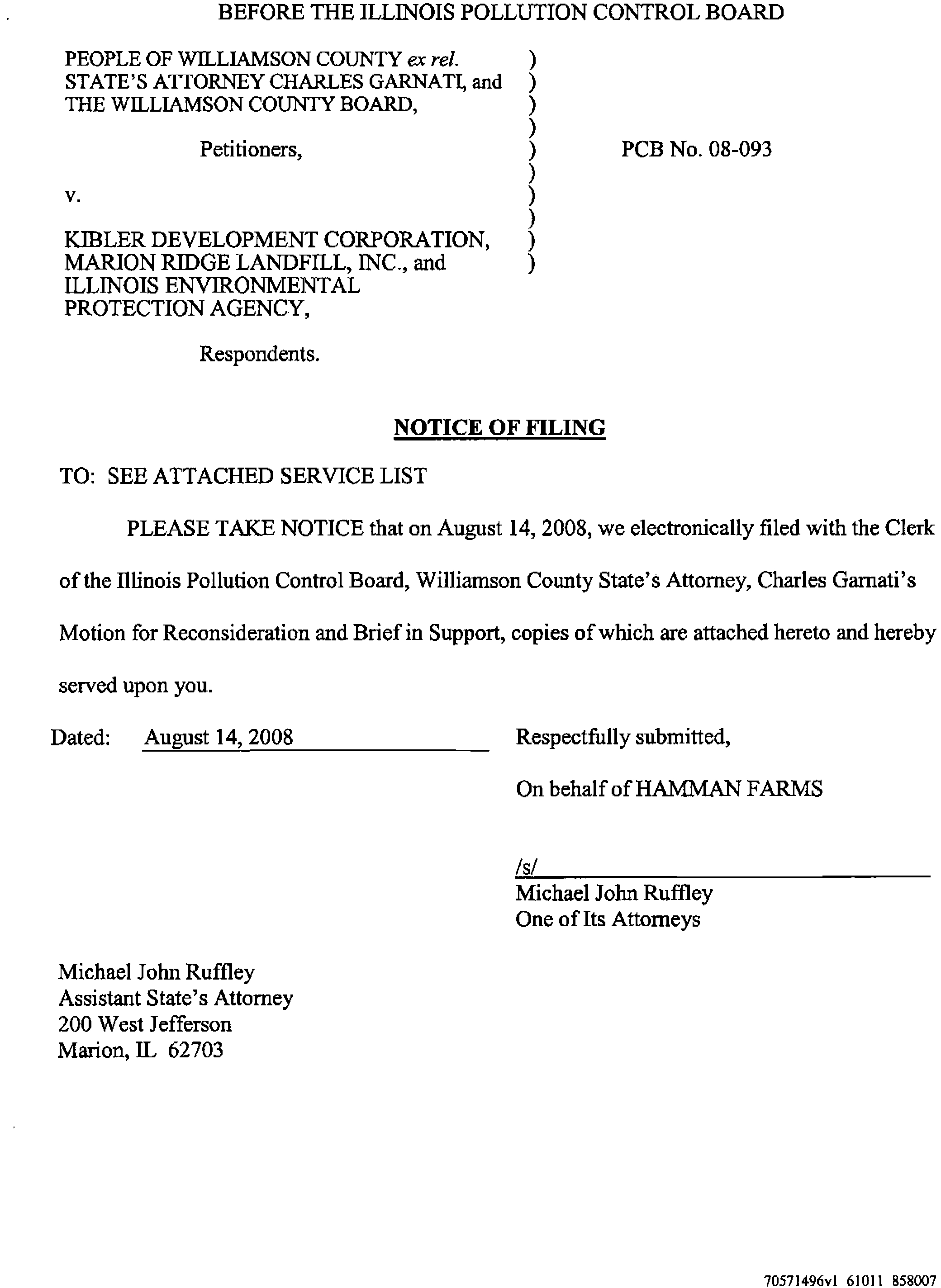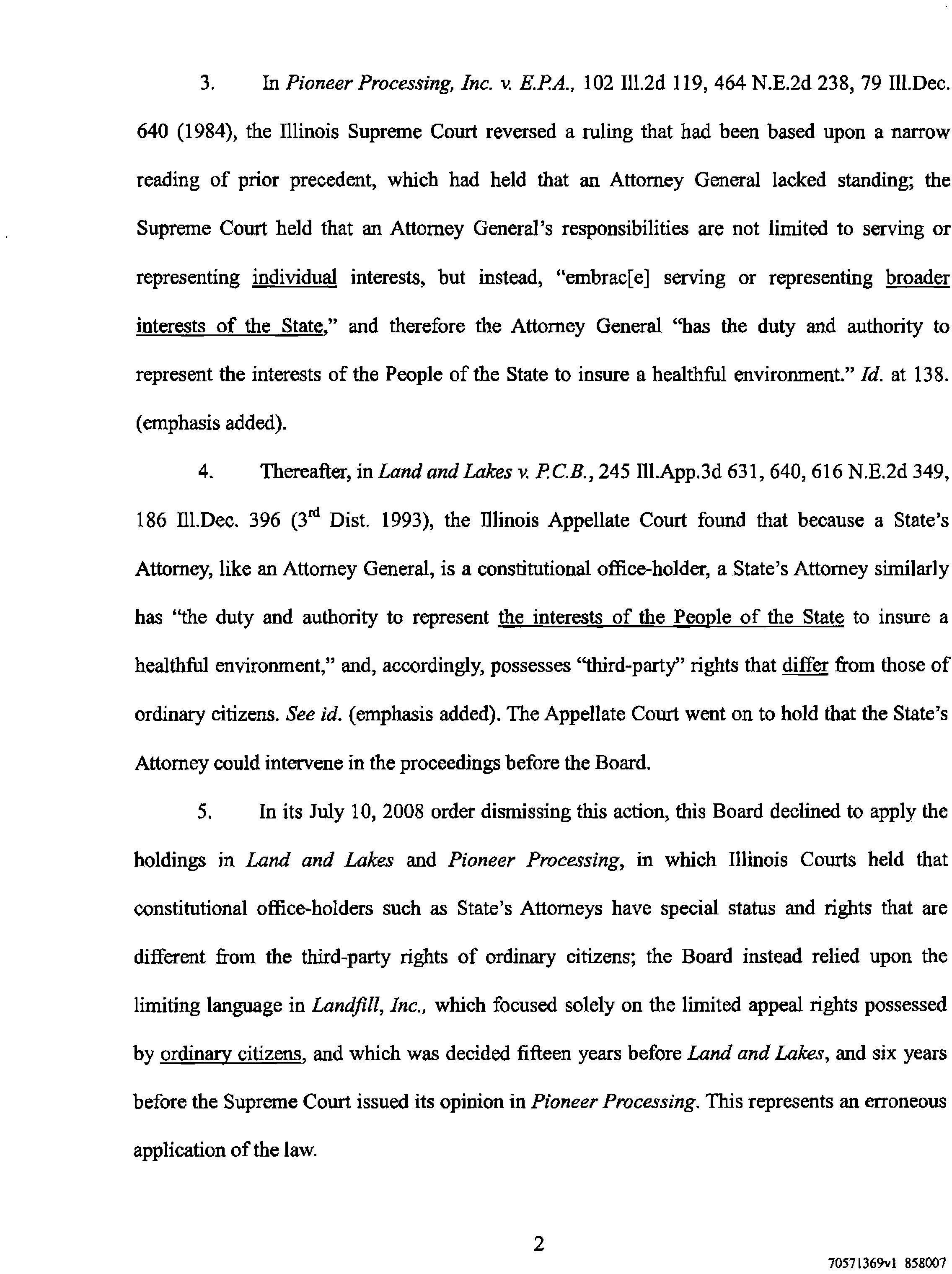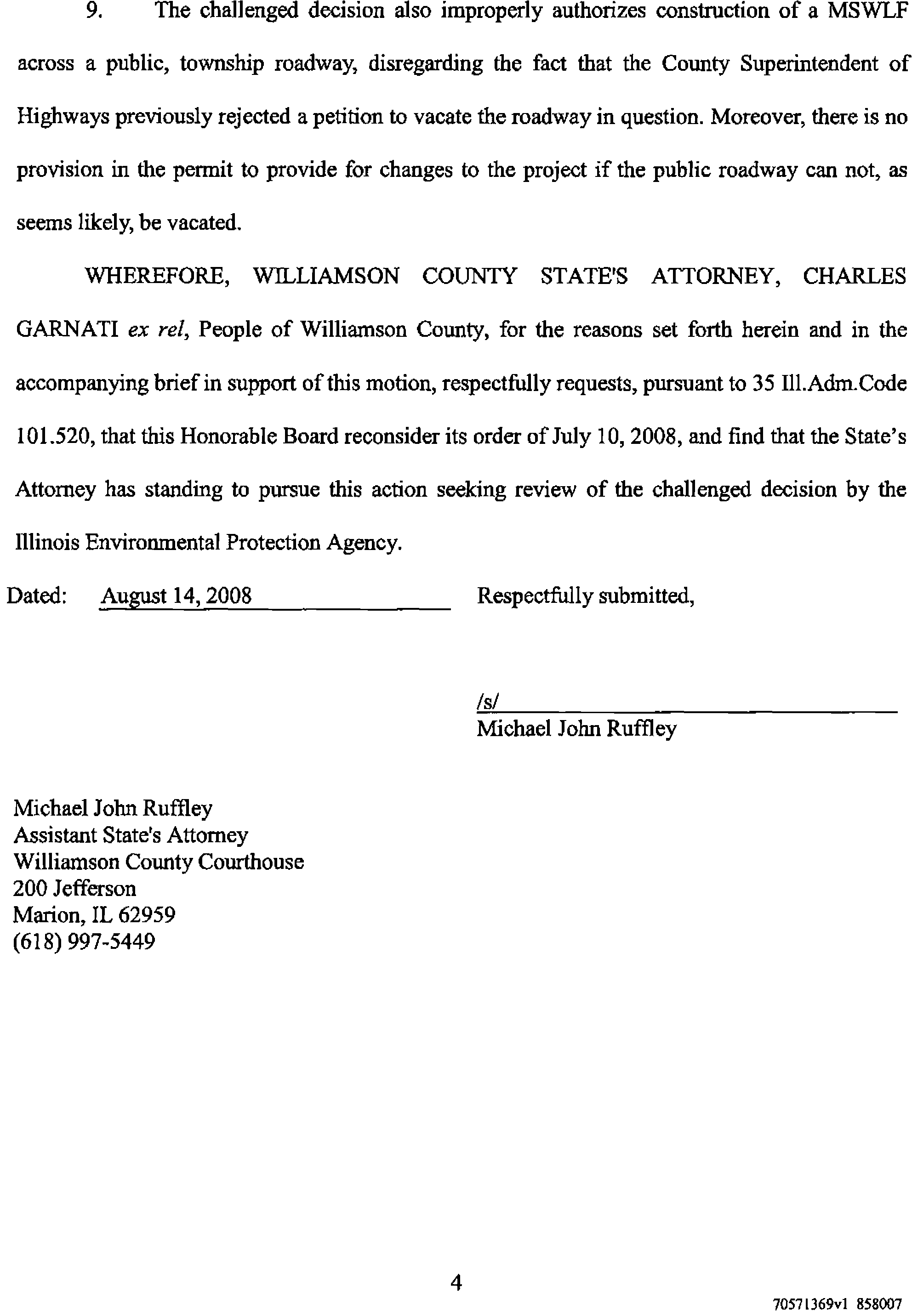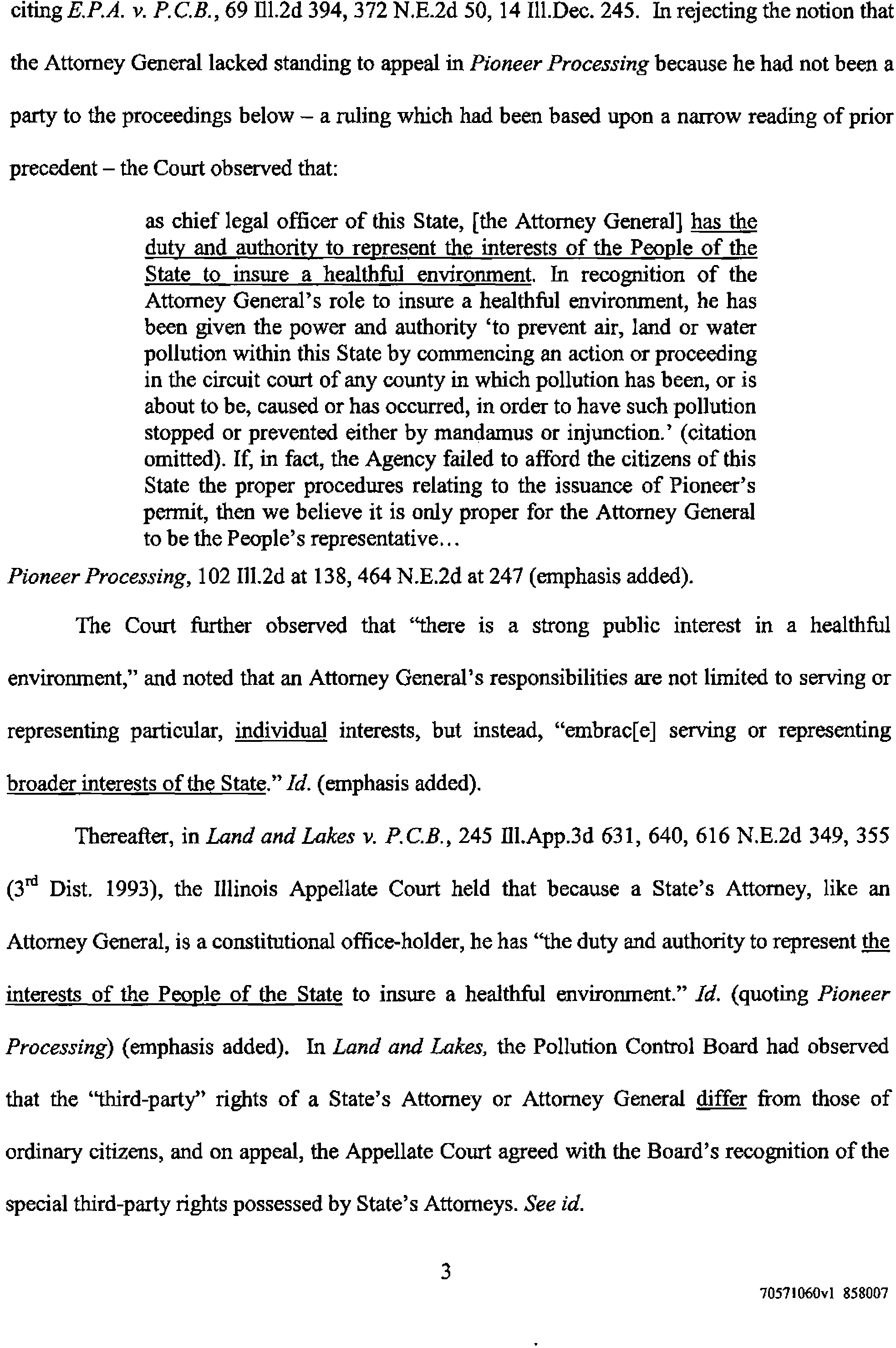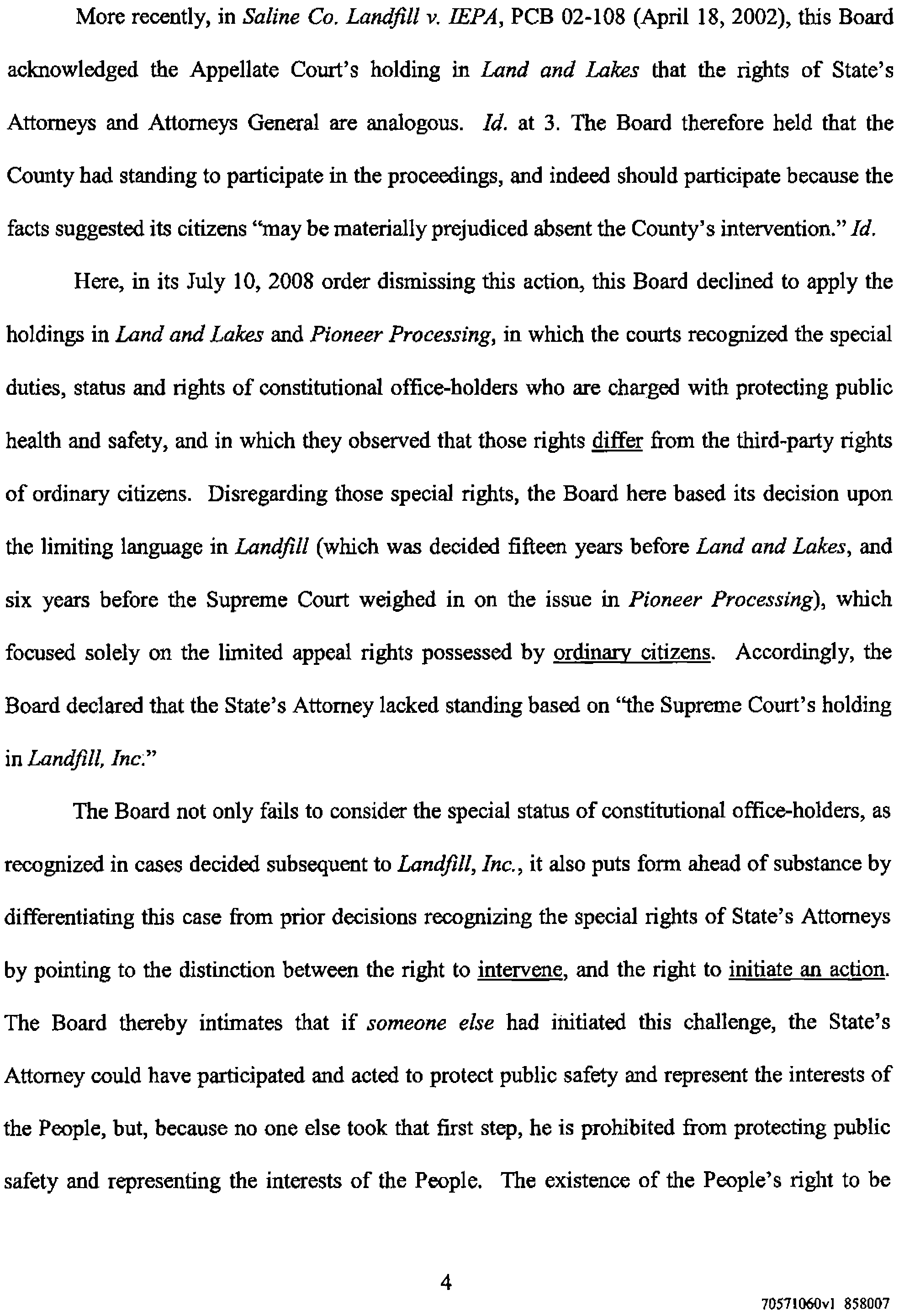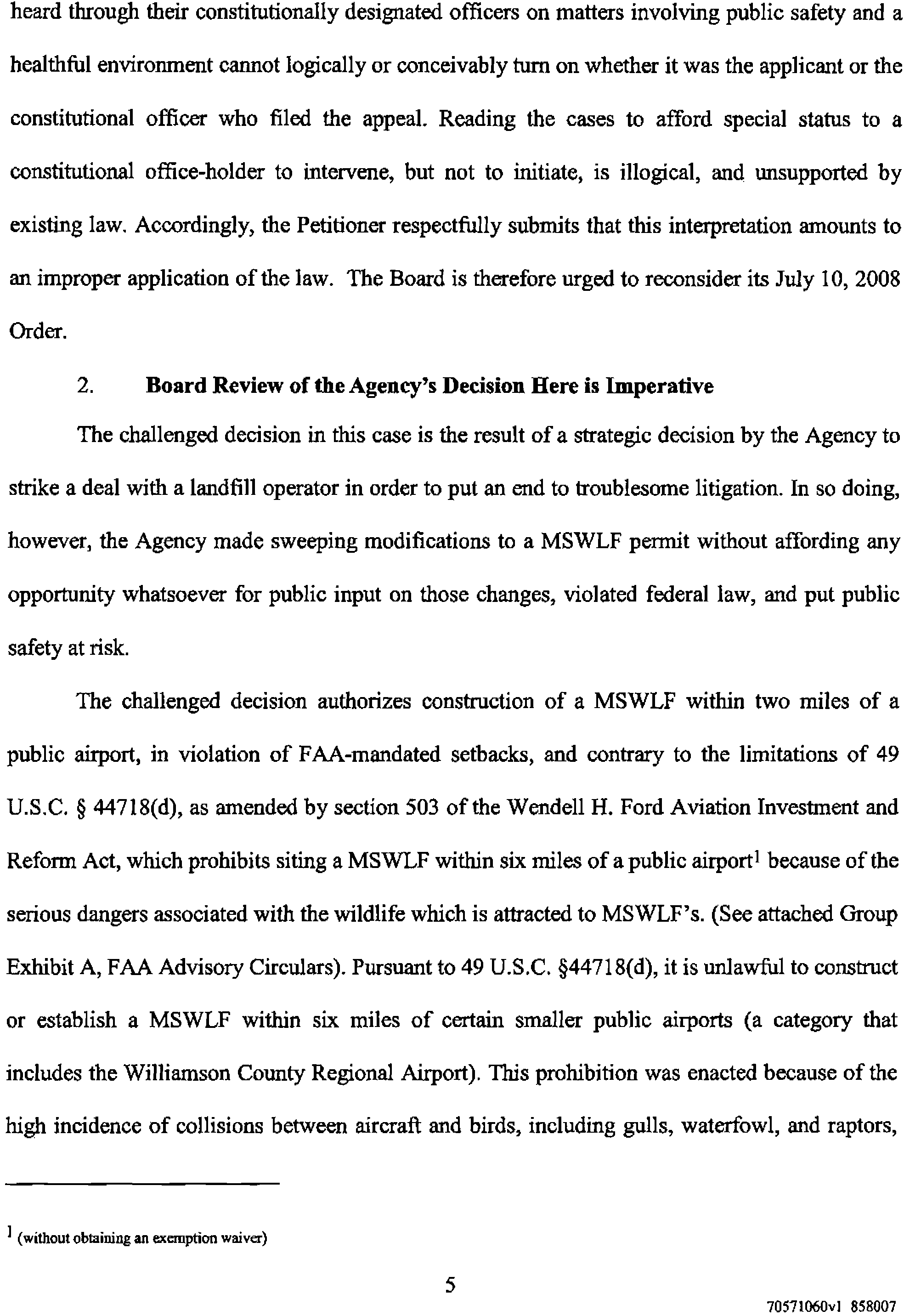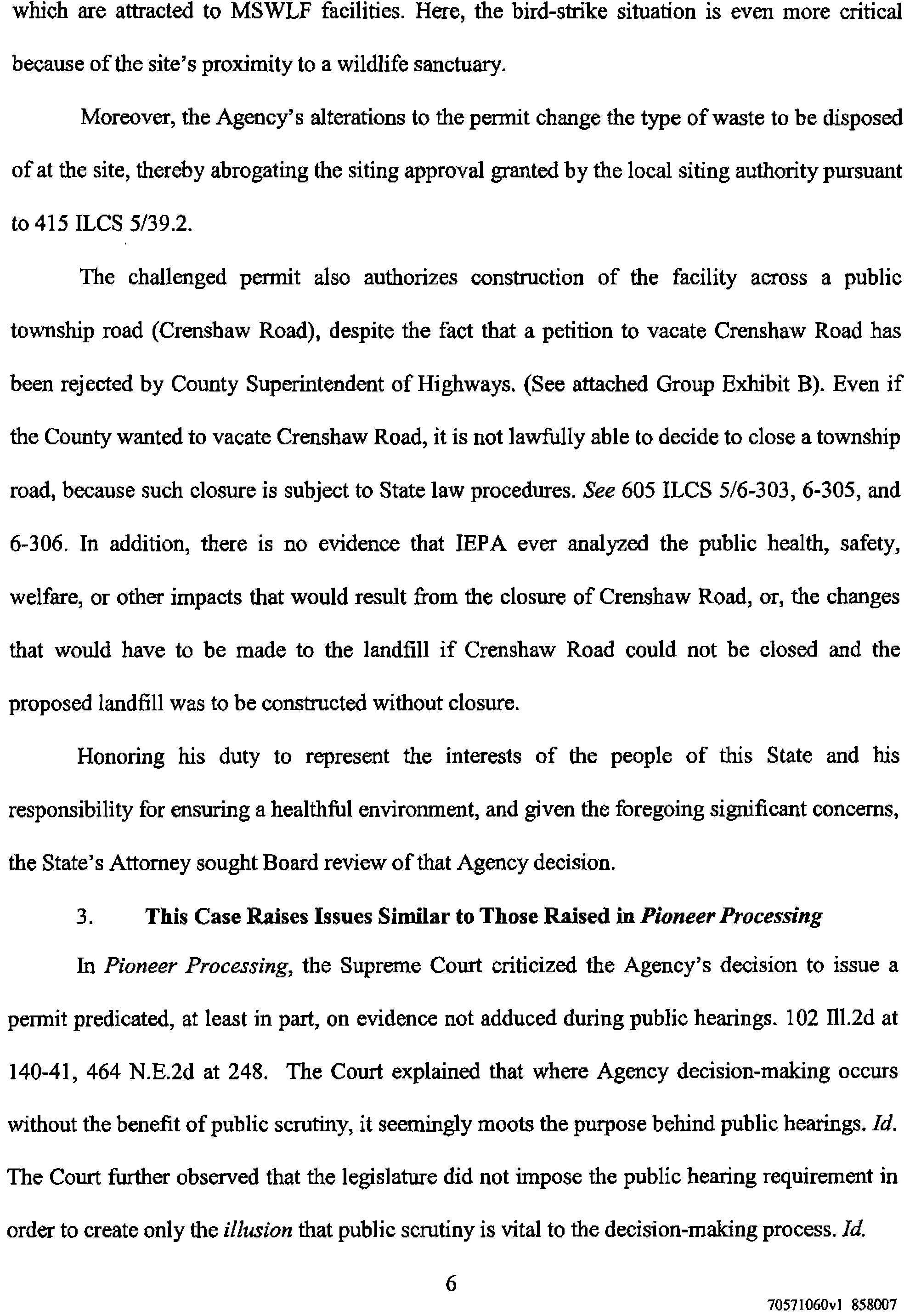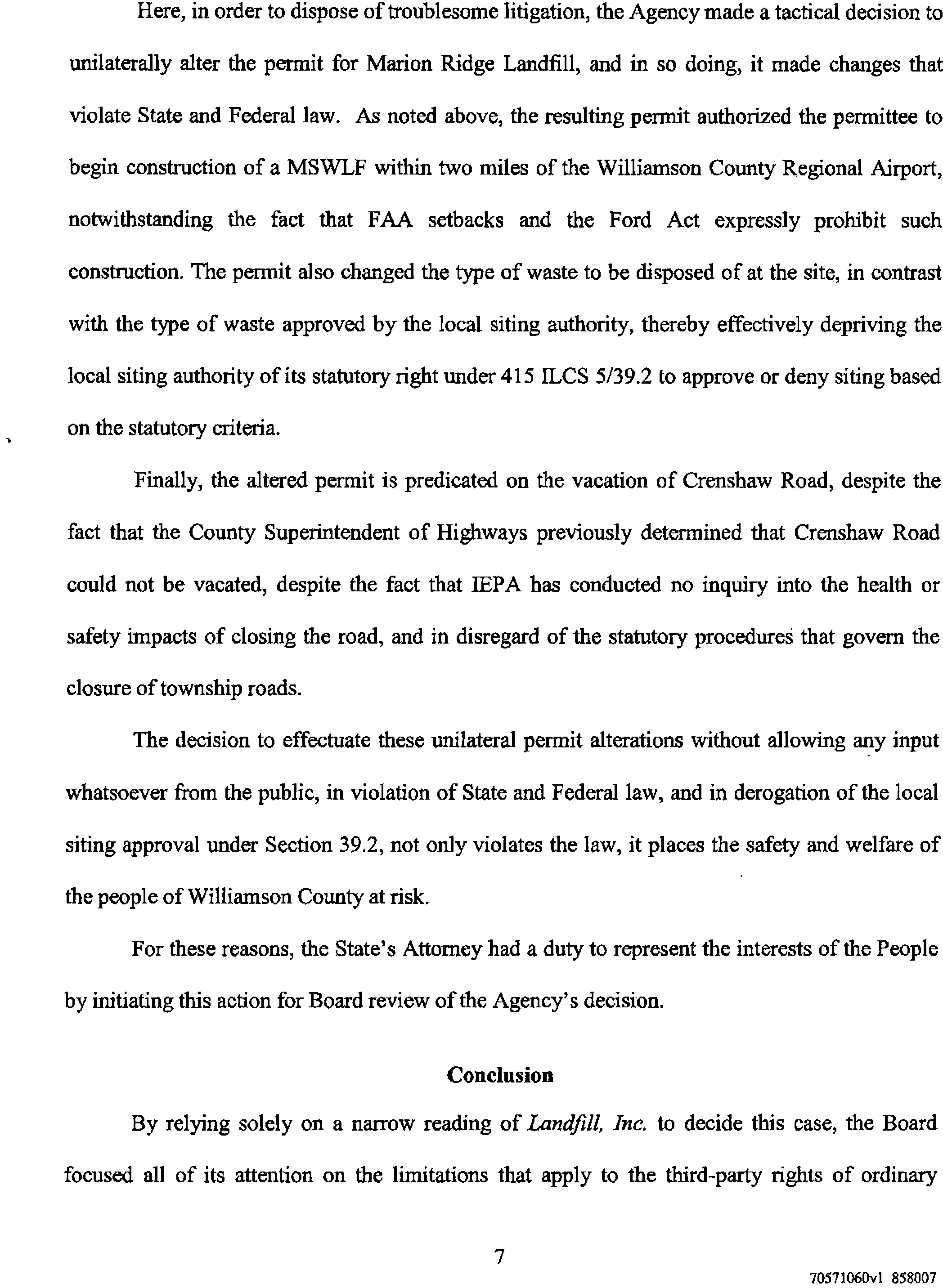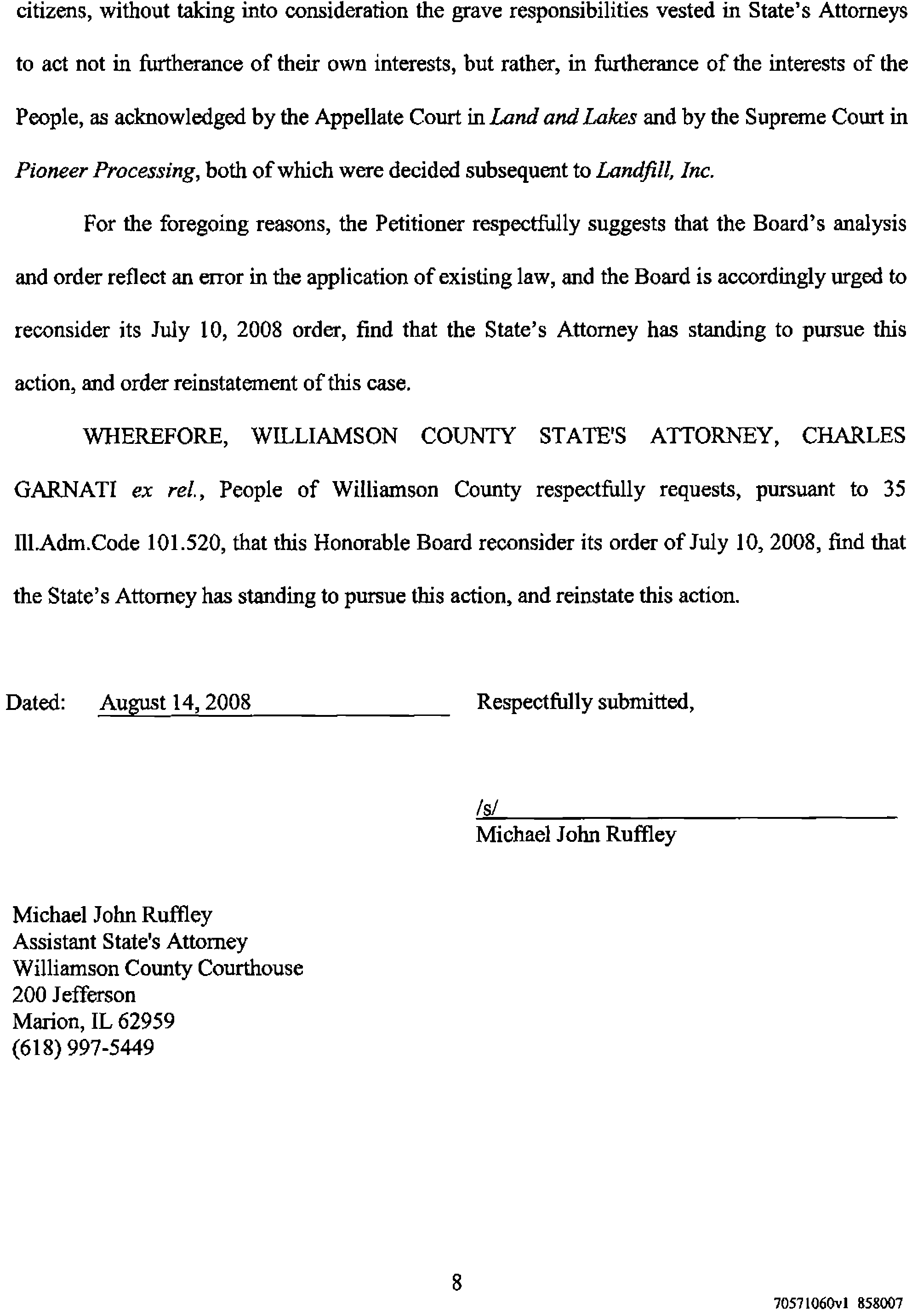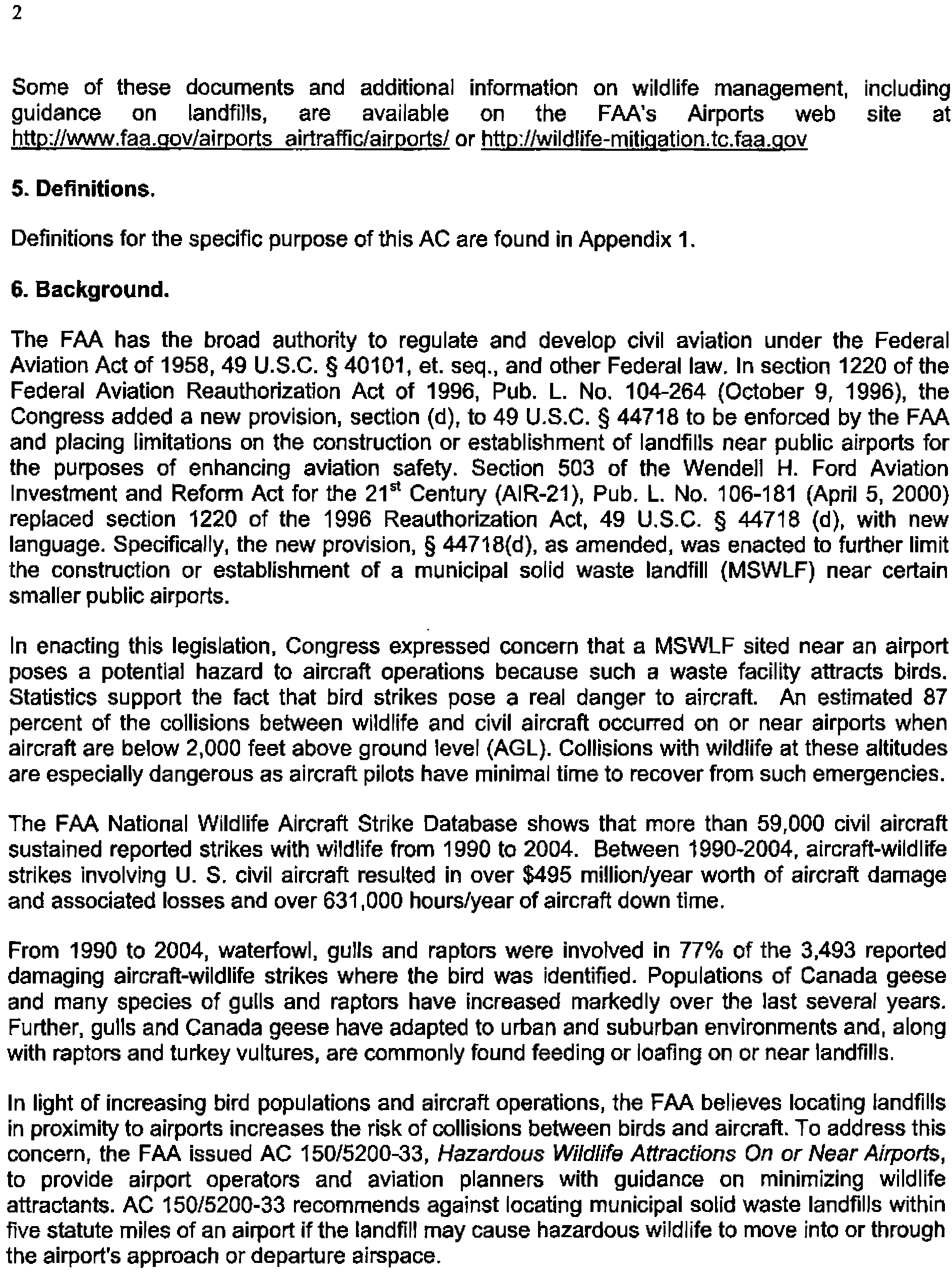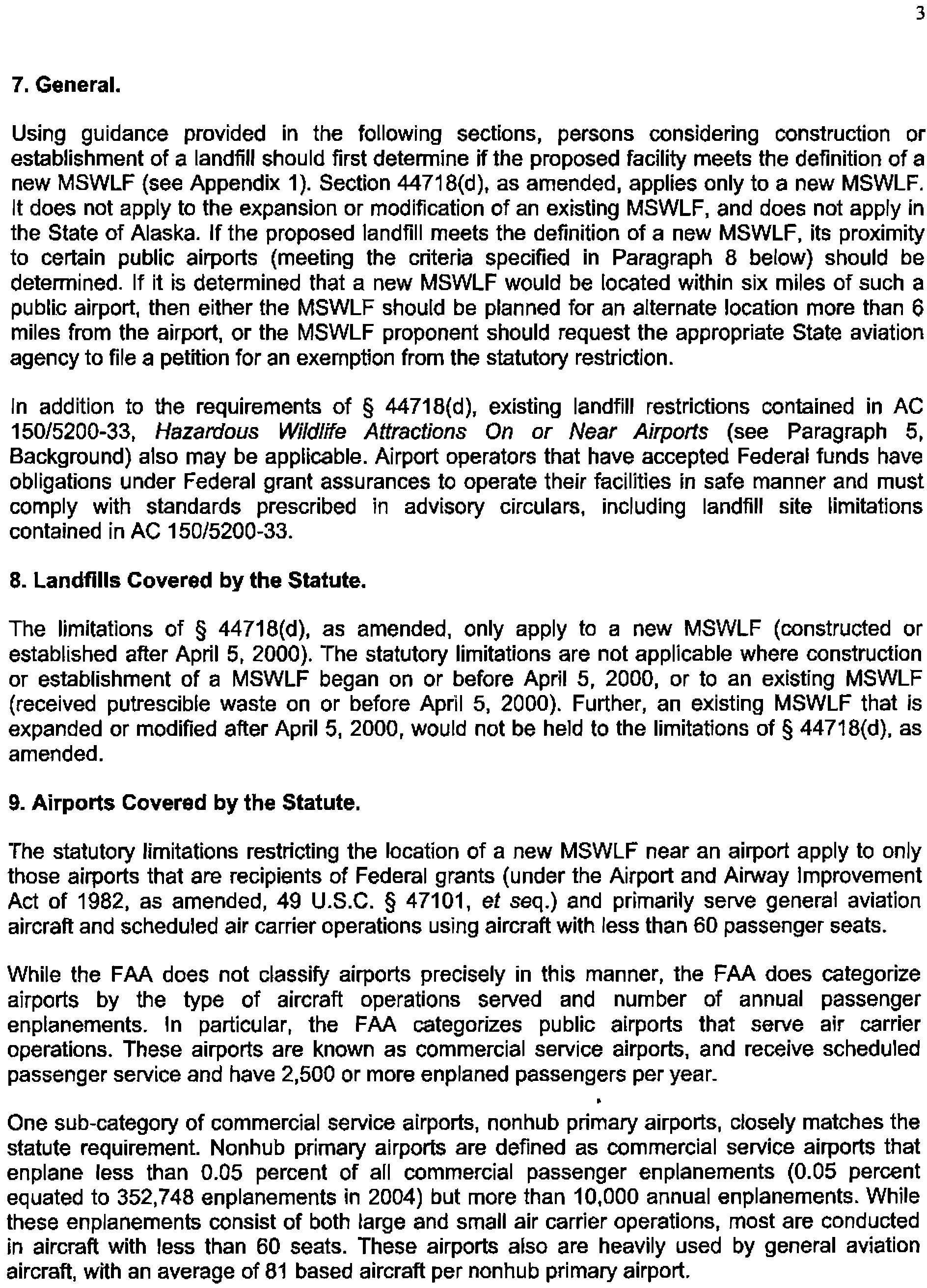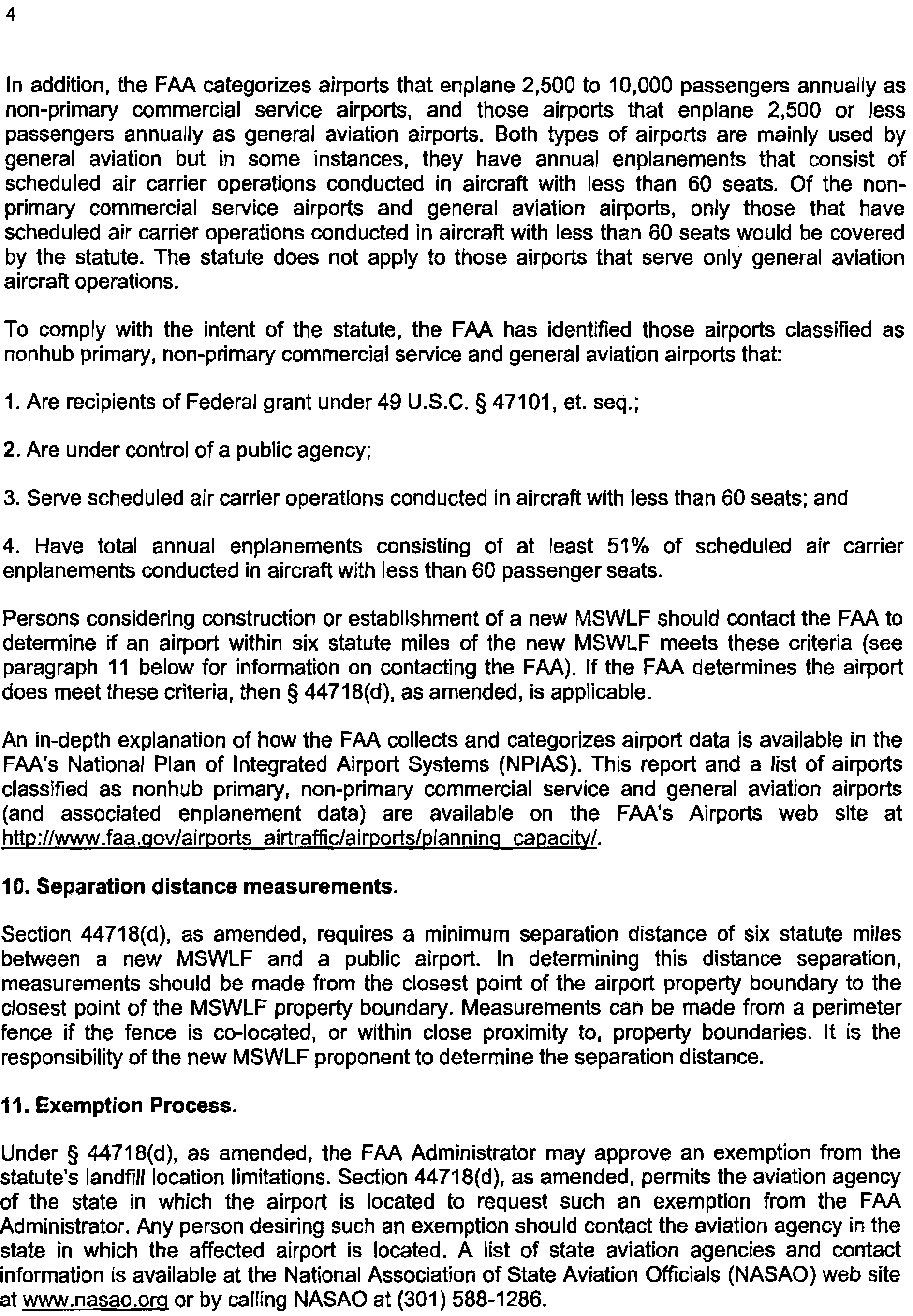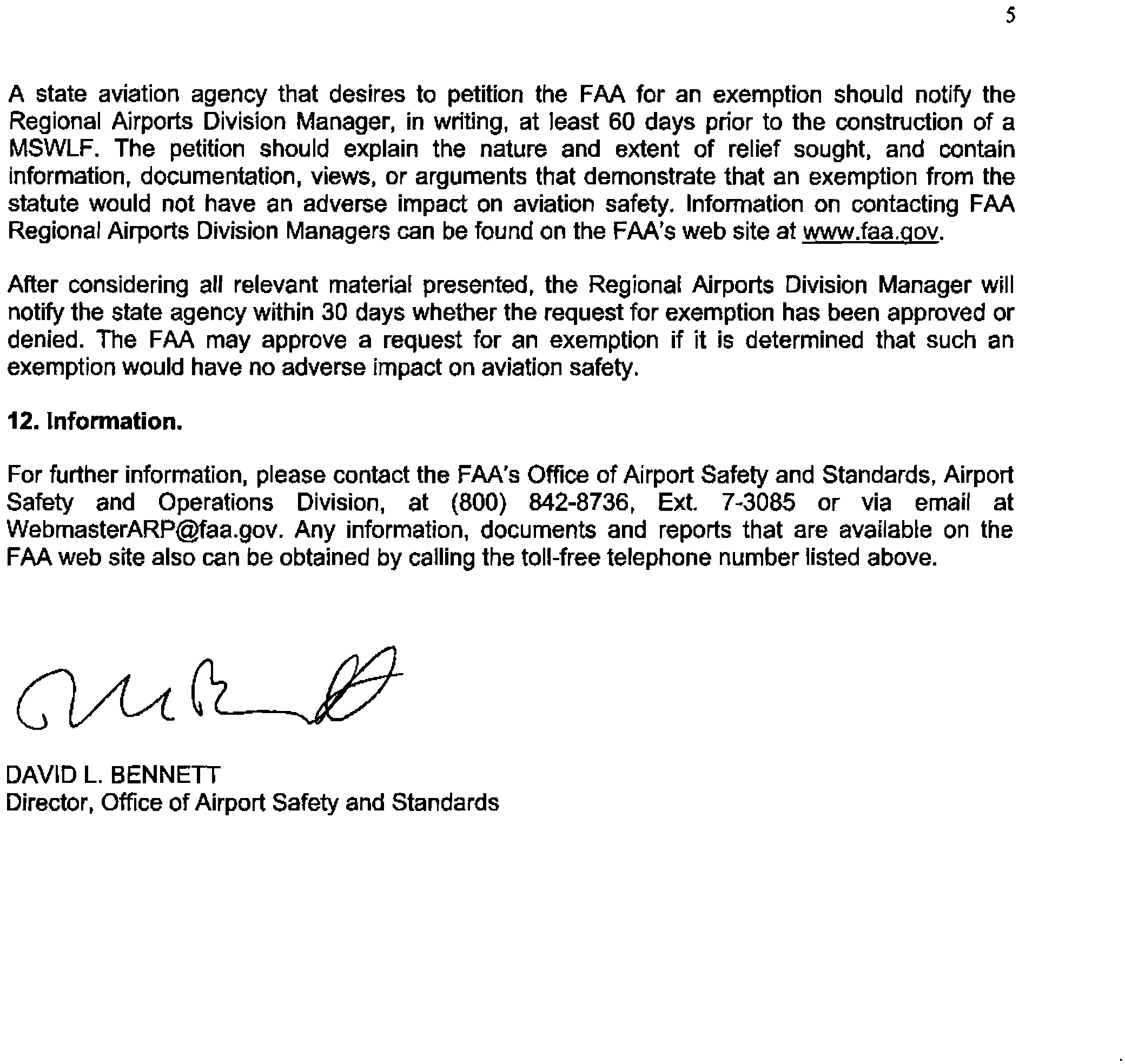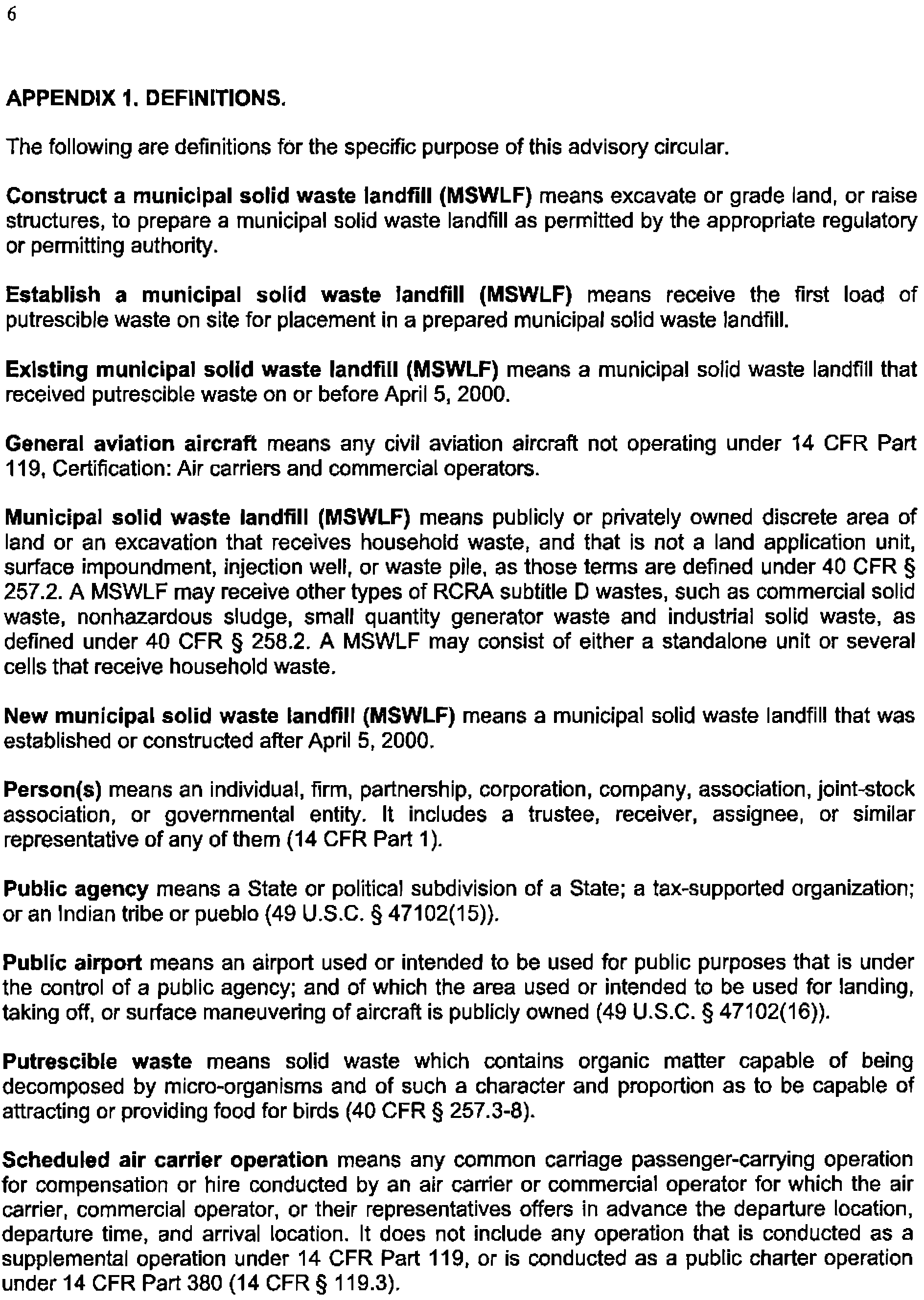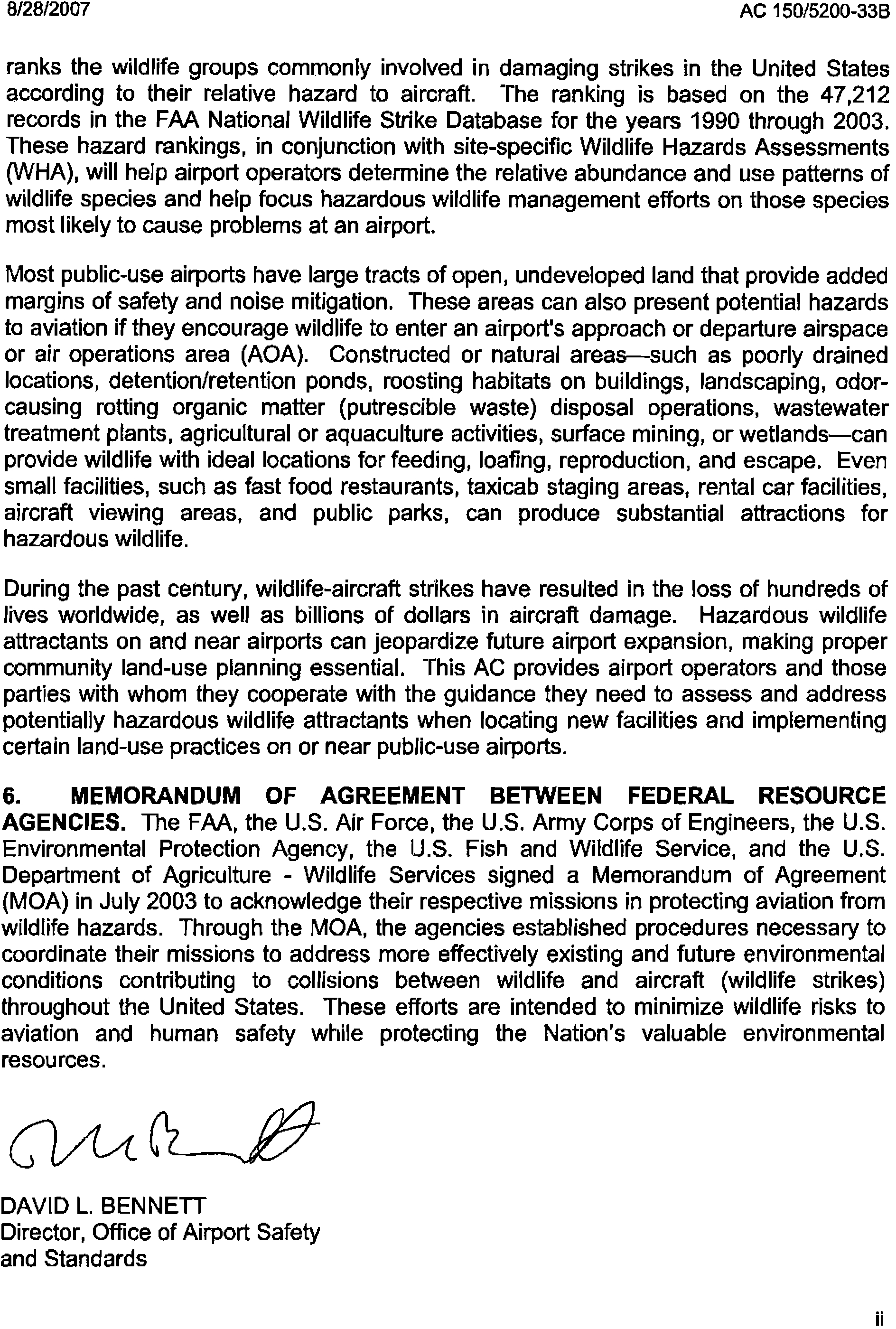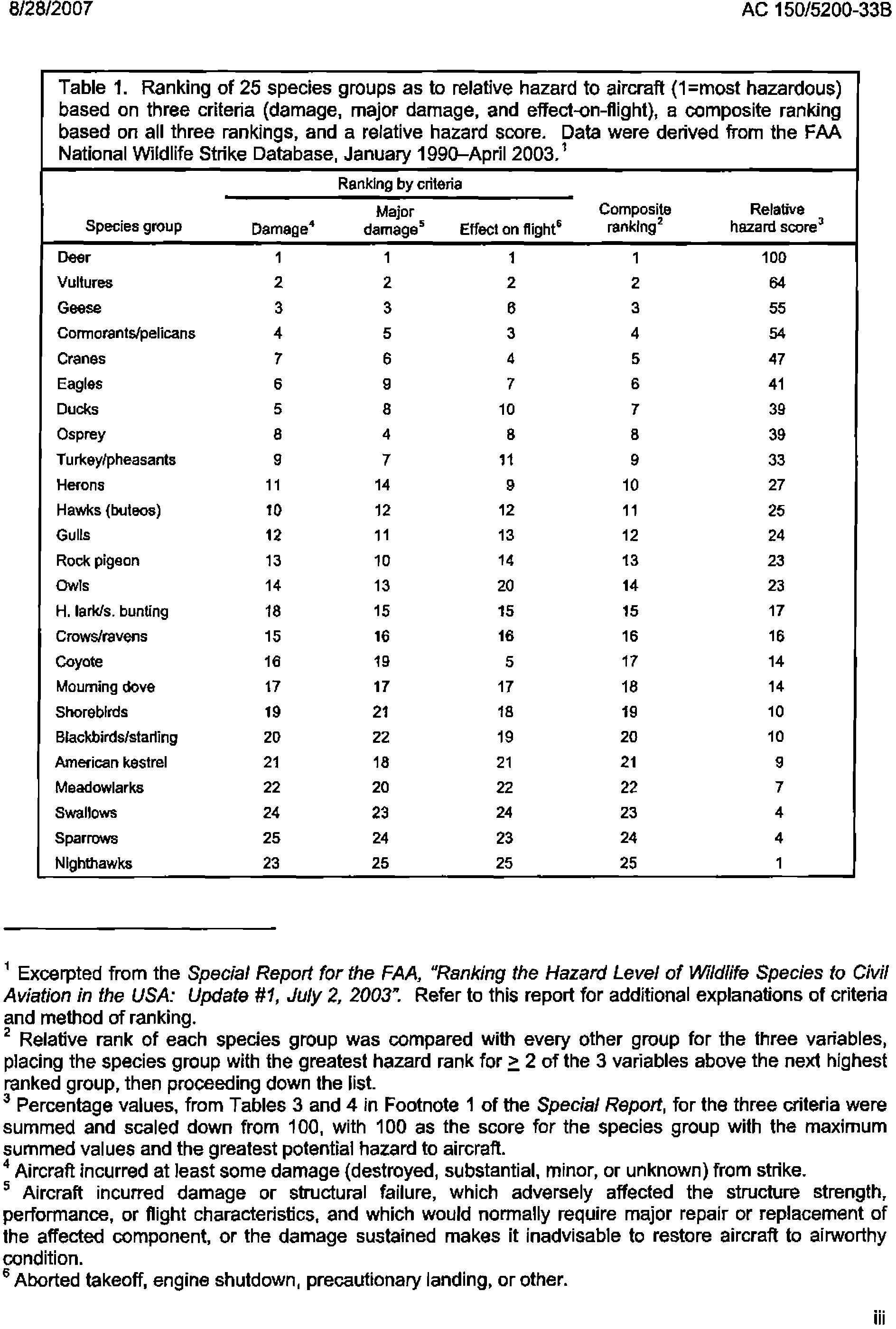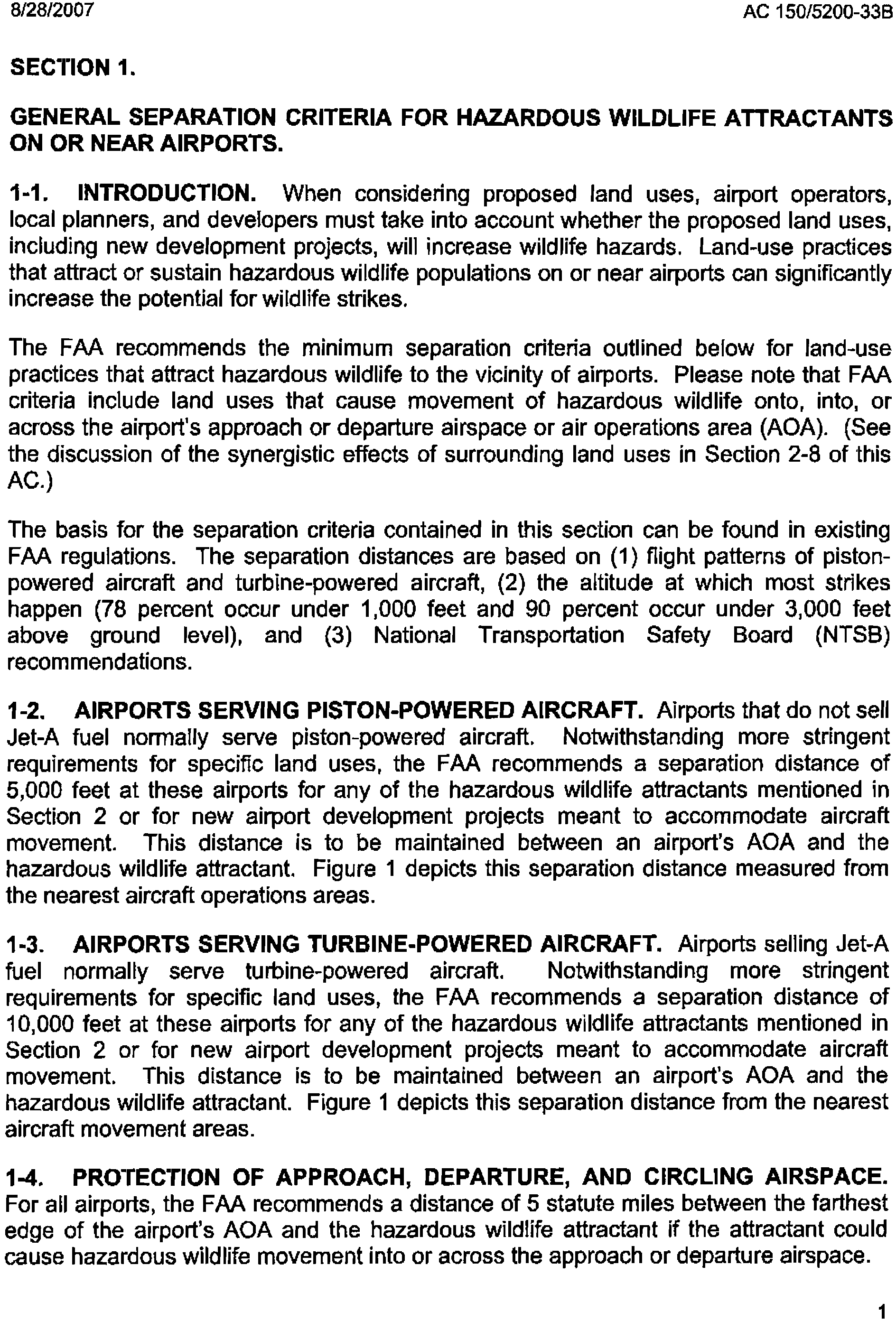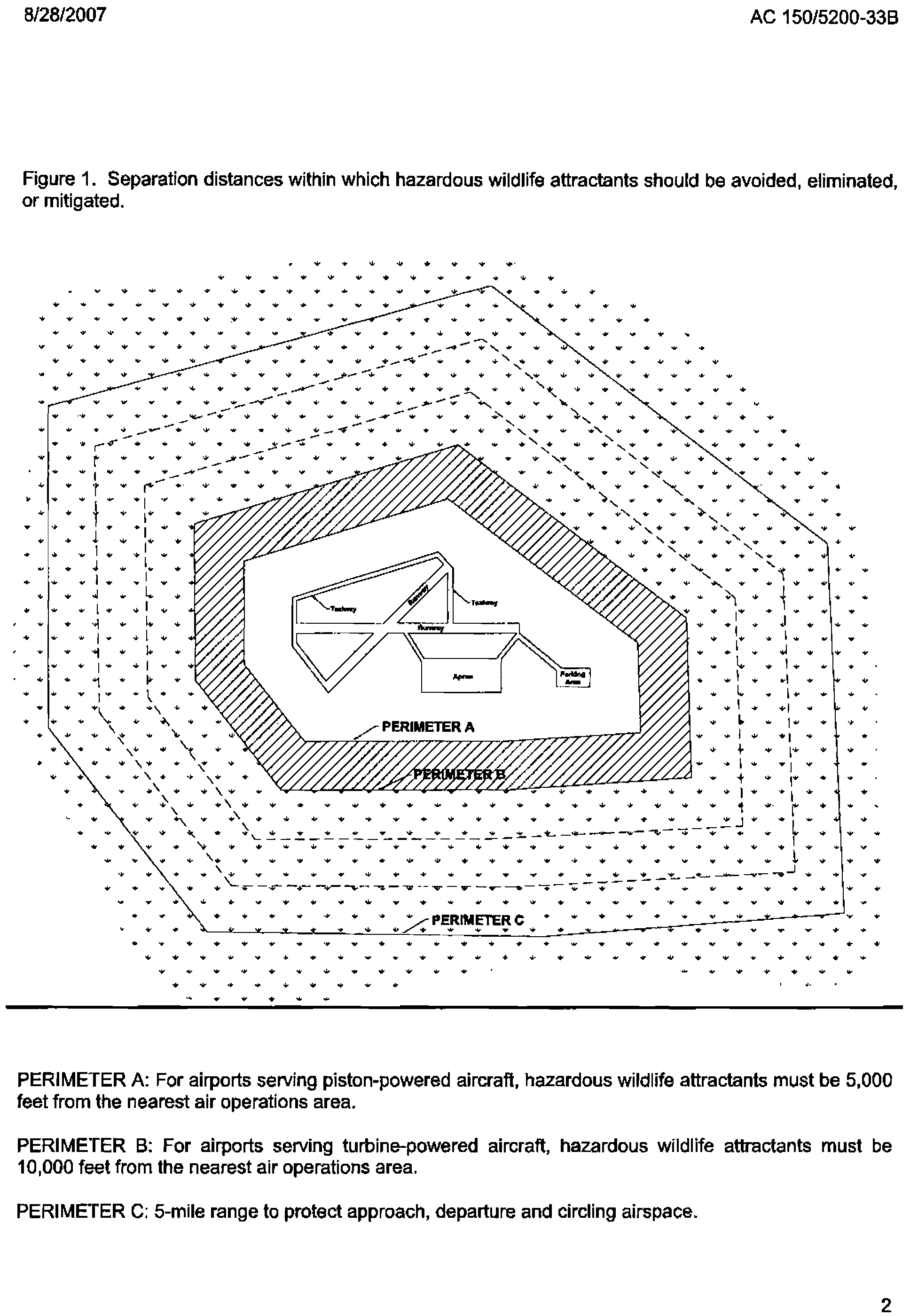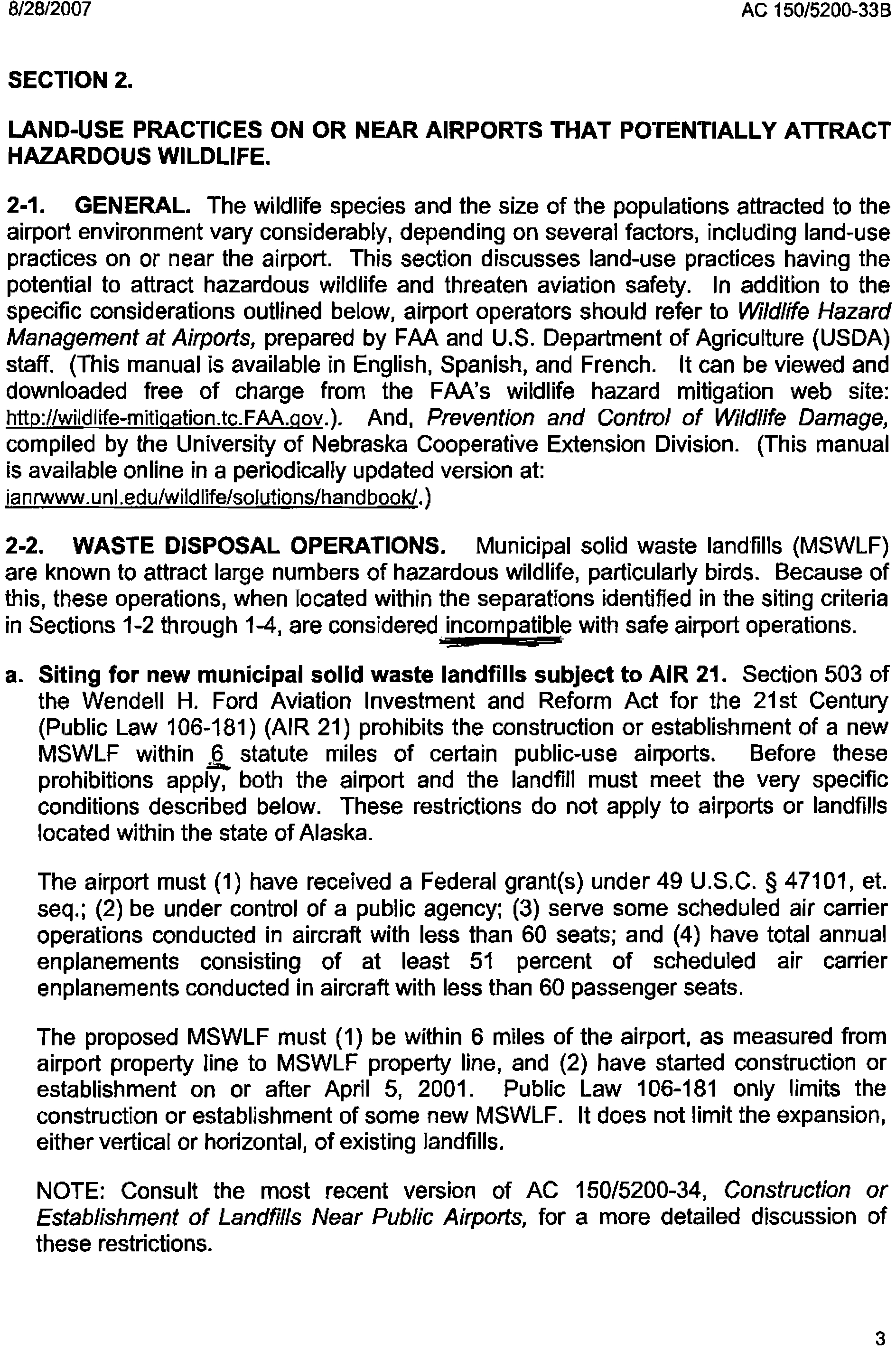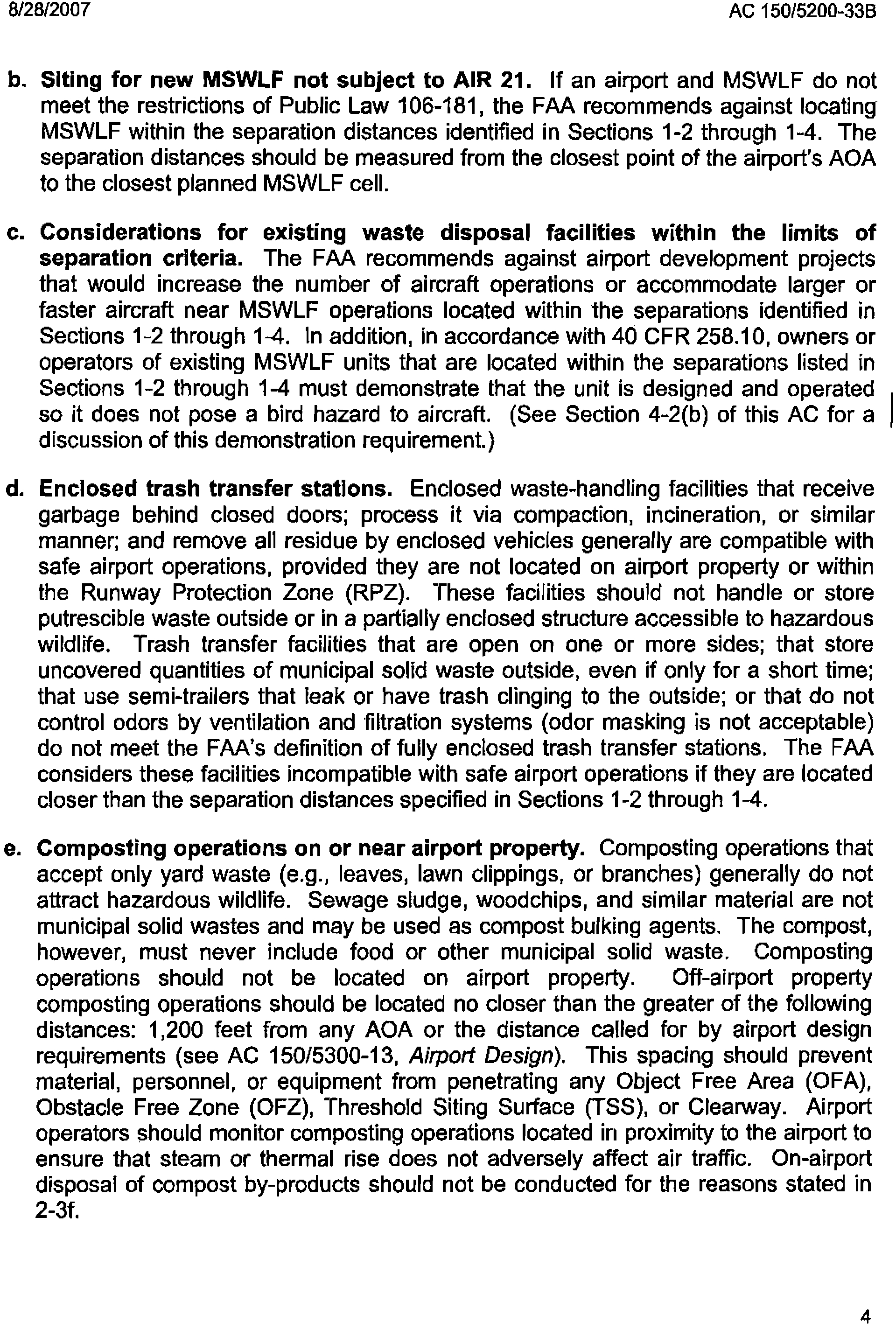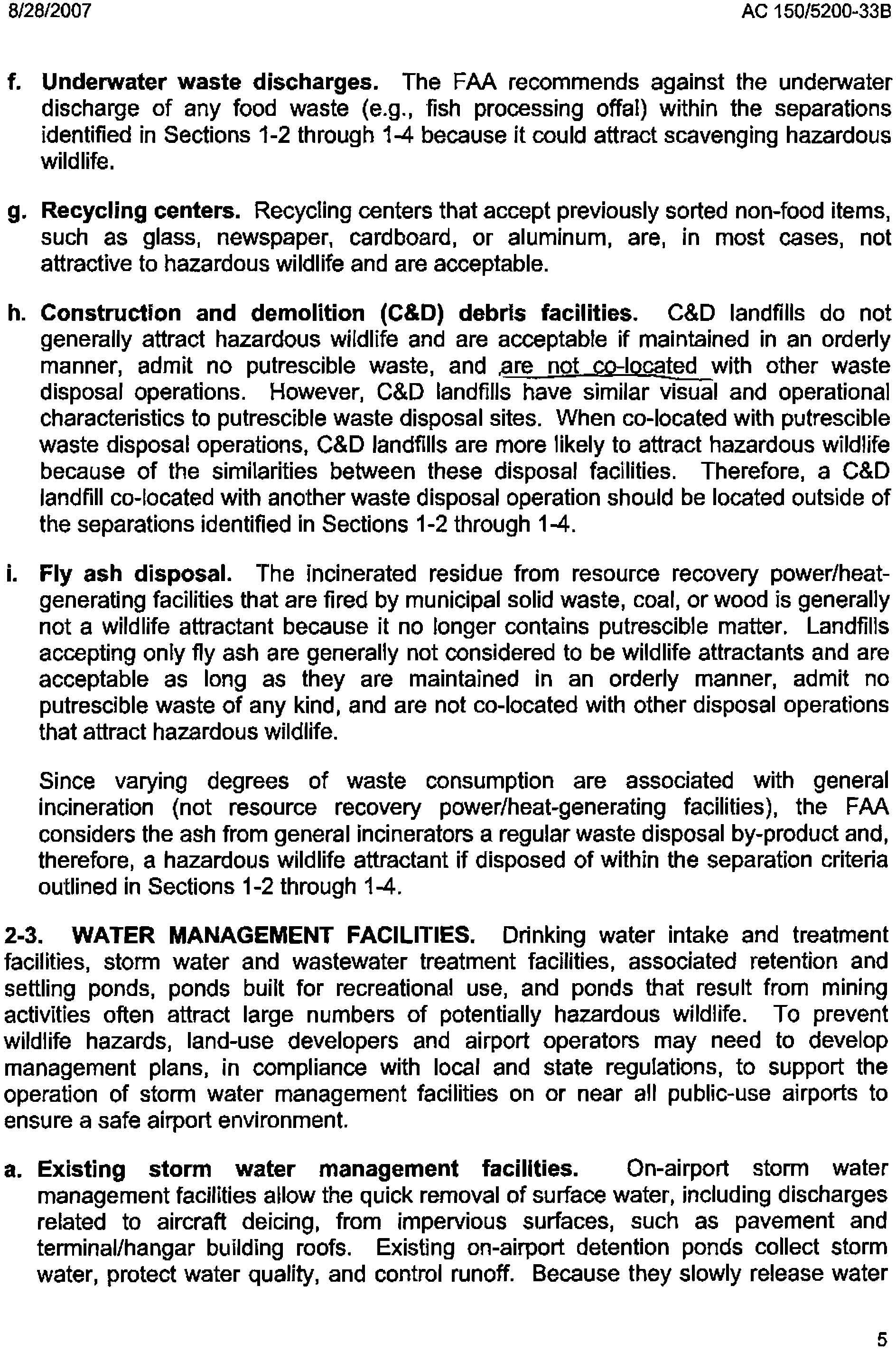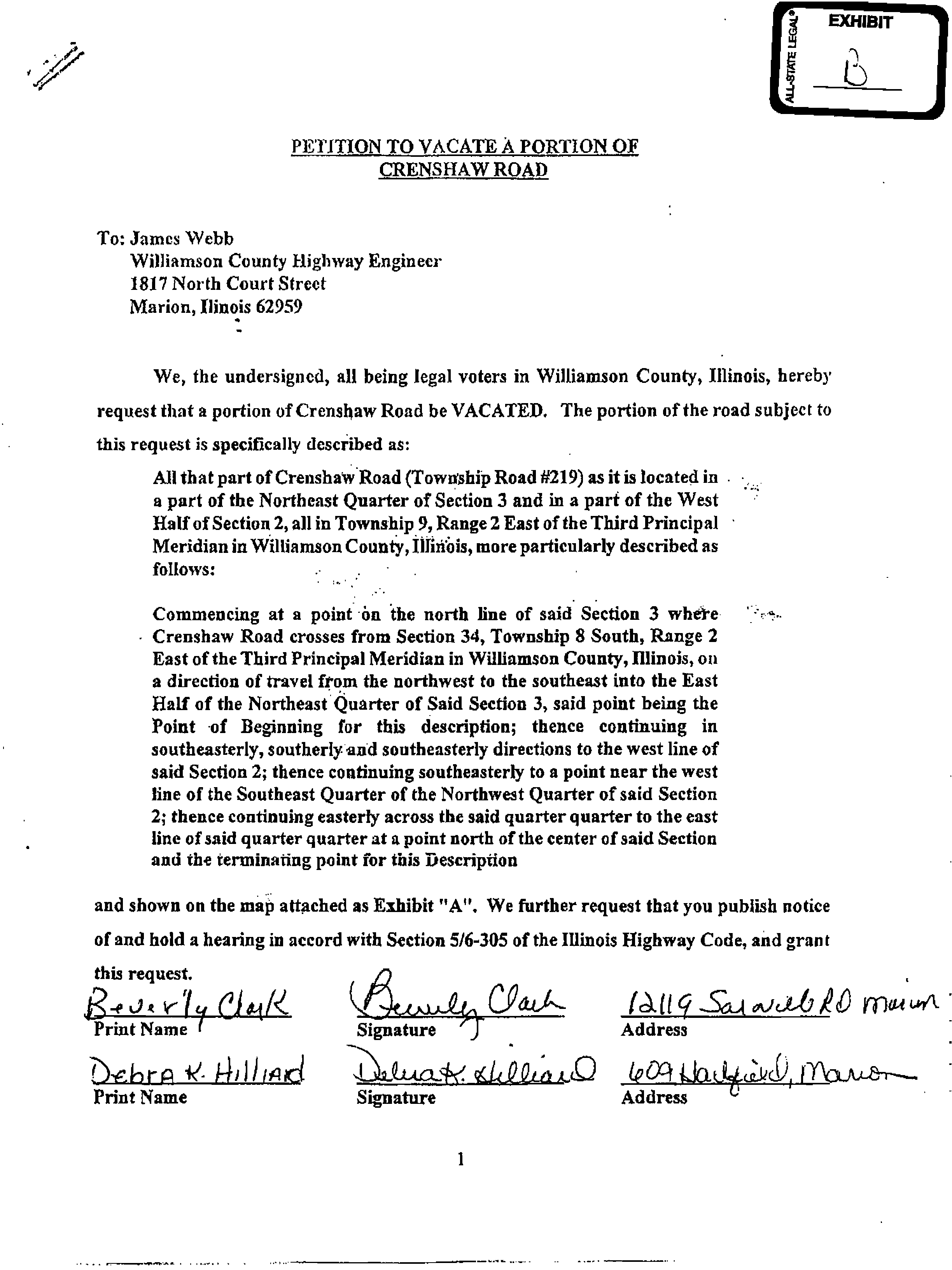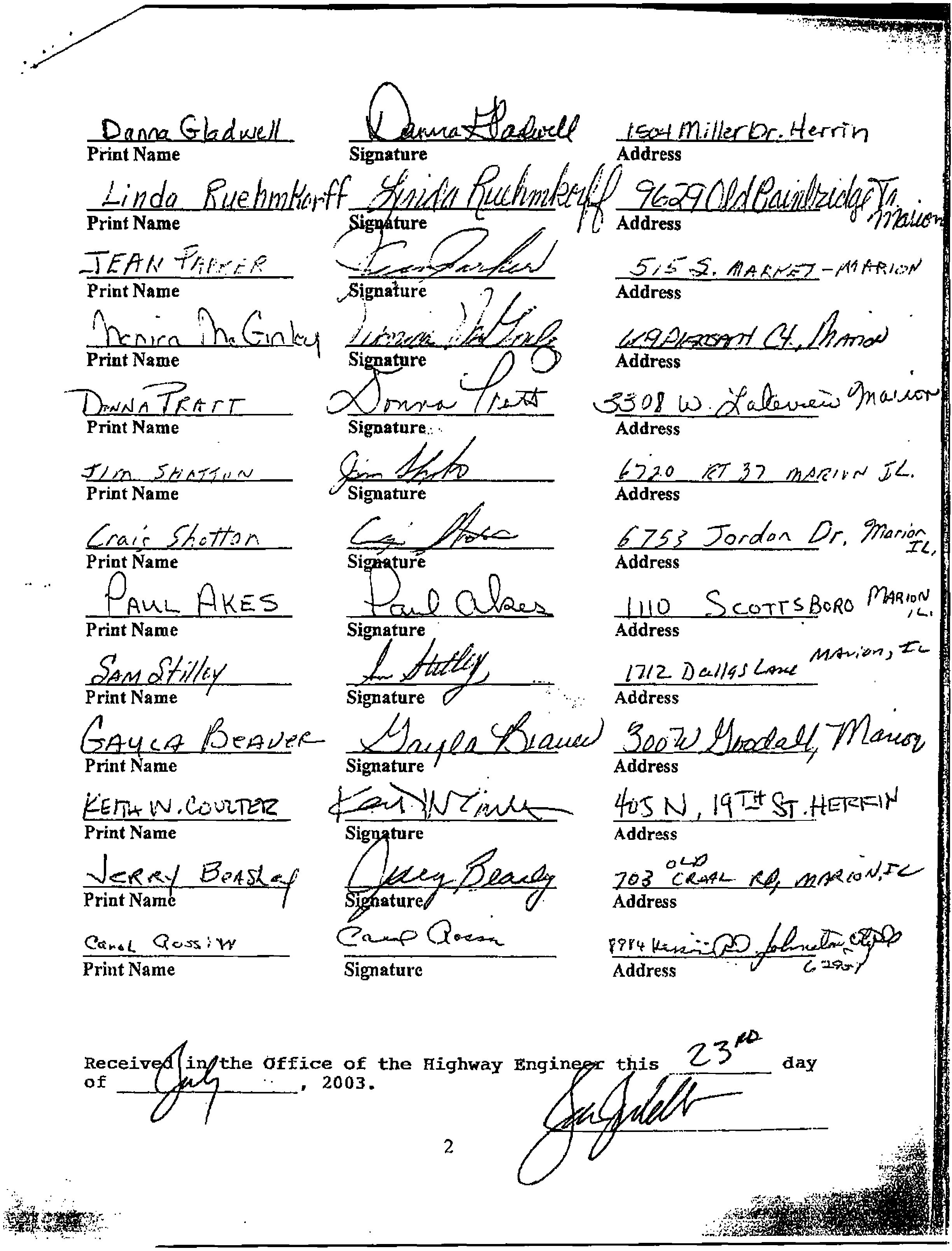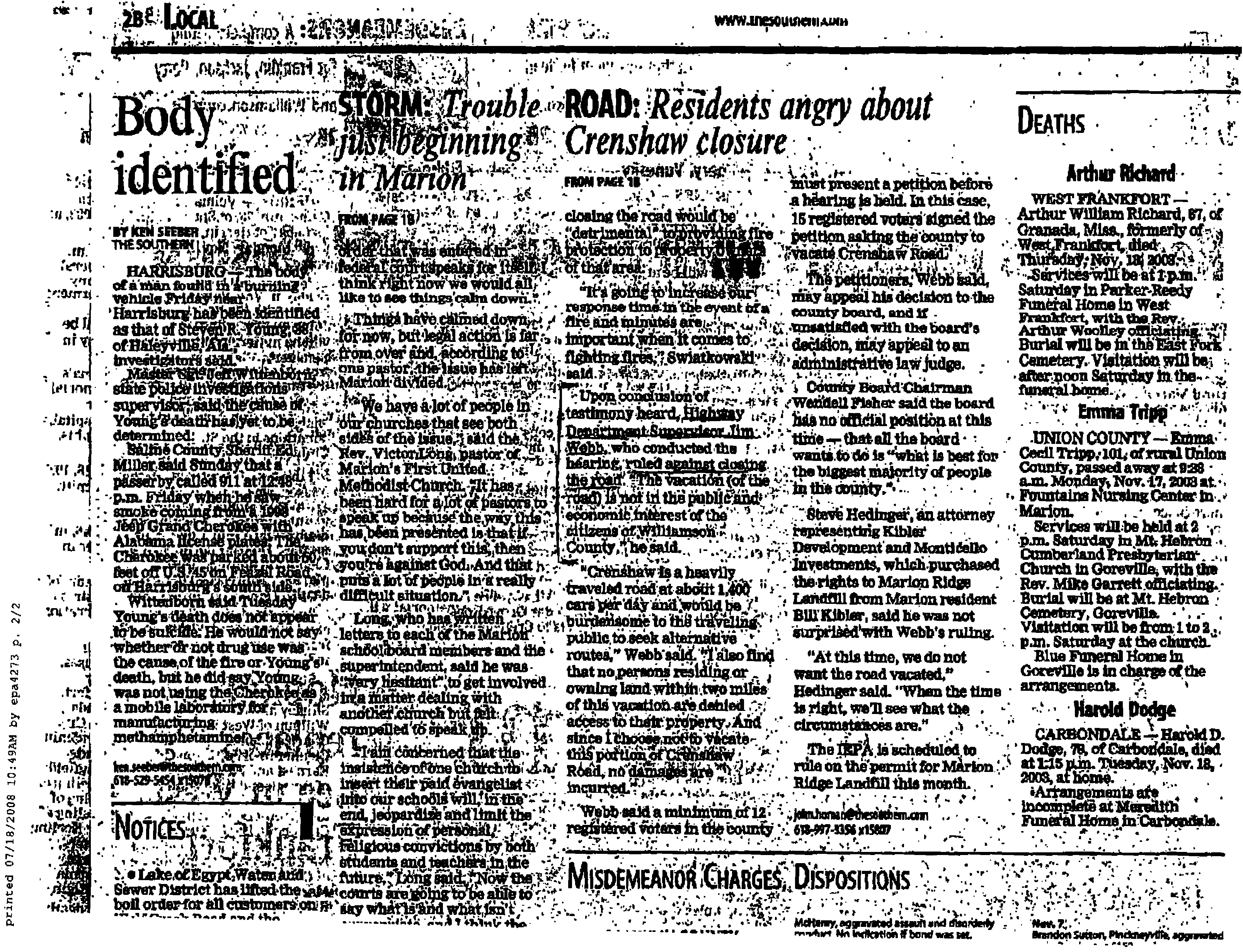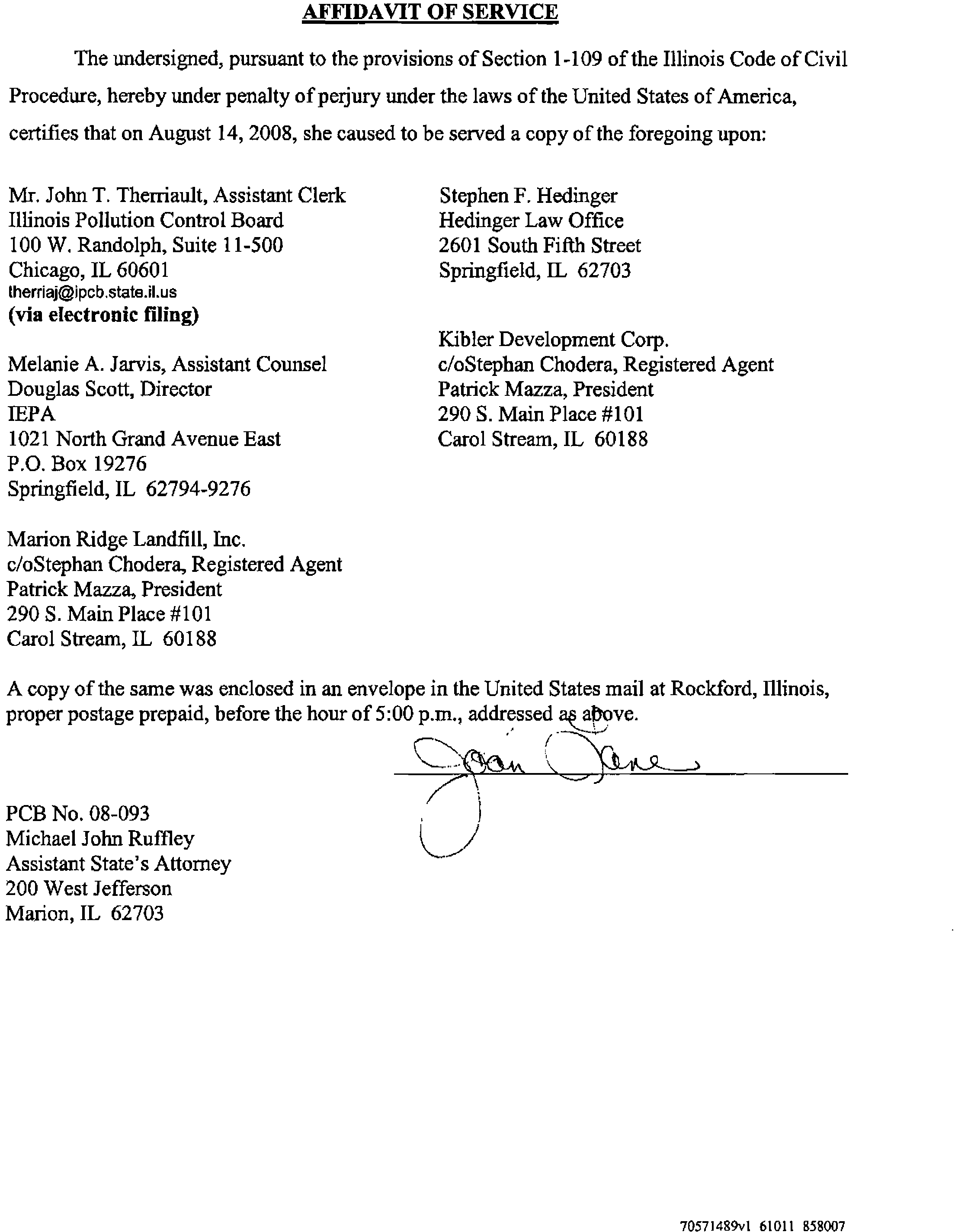BEFORE THE ILLINOIS POLLUTION CONTROL BOARD
KIBLER DEVELOPMENT CORPORATION,
MARION RIDGE LANDFILL, INC., and
ILLINOIS ENVIRONMENTAL
PROTECTION AGENCY,
Petitioners,
PCB No. 08-093
PEOPLE OF WILLIAMSON COUNTY
ex rei.
)
STATE'S ATTORNEY CHARLES GARNATI, and
)
THE WILLIAMSON COUNTY BOARD,
)
)
)
)
)
)
)
)
v.
Respondents.
NOTICE OF FILING
TO: SEE ATTACHED SERVICE LIST
PLEASE TAKE NOTICE that
on August 14,2008, we electronically filed with the Clerk
of the illinois Pollution Control Board, Williamson County State'sAttorney, Charles Garnati's
Motion for Reconsideration and
Brief in Support, copies ofwhich are attached hereto and hereby
served upon you.
Dated:
August
14, 2008
Respectfully submitted,
On behalf of HAMMAN FARMS
lsi
Michael John Ruffley
One of Its Attorneys
Michael
Jobo Ruffley
Assistant State'sAttorney
200 West Jefferson
Marion, IL 62703
10571496v1 61011 858007
???????????
??????? ?? ??????????
???????? ???????? ??????? ???? ????
BEFORE THE ILLINOIS POLLUTION CONTROL BOARD
KIBLER DEVELOPMENT CORPORATION,
MARION RIDGE LANDFILL, INC., and
ILLINOIS ENVIRONMENTAL
PROTECTION AGENCY,
Petitioners,
PCB No. 08-093
PEOPLE
OF WILLIAMSON COUNTY
ex rei.
)
STATE'S ATTORNEY CHARLES GARNATI, and
)
THE WILLIAMSON COUNTY BOARD,
)
)
)
)
)
)
)
)
v.
Respondents.
wn..LIAMSON COUNTY STATE'SATTORNEY, CHARLES GARNATI'S MOTION
FOR RECONSIDERATION
NOW COMES WILLIAMSON COUNTY STATE'S ATTORNEY, CHARLES
GARNATI
ex rei.,
People of Williamson County, pursuant to 35 TIl.Adm.Code 101.520, and
moves this Honorable Board to reconsider its order of July 10, 2008, stating
as
follows:
1.
A motion for reconsideration may be used to call the Board's attention to newly
discovered evidence, changes in the law, or errors in application ofthe existing law. The
Citizens
Against Regional Landfill
v.
County Board of Whiteside,
PCB 93-156 (Mar. 11, 1993) (citing
Korogluyan v. Chicago TItle
&
Trust Co.,
213 Ill. App. 3d 622,627,572 N.E.2d 1154, 1158 (1st
Dist. 1992». Here, the Board is urged to reconsider its application of existing law.
2.
In its July 10, 2008 order dismissing this case based upon a lack of standing, the
Board erroneously relied upon a 1978 case,
Landfill, Inc.
v.
PCB,
74 TIl.2d 541,387 N.E.2d 258,
25 Ill.Dec. 602 (1978), which addressed limitations on the third party rights of ordinary citizens.
However, the Board failed to apply relevant precedent from subsequent decisions which have
established that, as constitutional office-holders, State'sAttorneys possess special rights that are
distinct from, and greater
than, the third-party rights of ordinary citizens.
70571369vl 858007
???????????
??????? ?? ??????????
???????? ???????? ??????? ???? ????
3.
In
Pioneer Processing, Inc.
v.
E.P.A.,
102 Il1.2d 119,464 N.E.2d 238, 79 Ill.Dec.
640 (1984), the lllinois Supreme Court reversed a ruling that had been based upon a narrow
reading
of prior precedent, which had held that an Attorney General lacked standing; the
Supreme Court held that an Attorney General's responsibilities are not limited to serving
or
representing individual interests, but instead, "embrac[e] serving or representing broader
interests
of the State," and therefore the Attorney General ''has the duty and authority to
represent the interests
of the People of the State to insure a healthful environment."
ld.
at 138.
(emphasis added).
4.
Thereafter, in
Land and Lakes
v.
P.CB.,
245 1ll.App.3d 631,640,616 N.E.2d 349,
186 m.Dec. 396
(3
rd
Dist. 1993), the lllinois Appellate Court found that because a State's
Attorney, like an Attorney General, is a constitutional office-holder, a State'sAttorney similarly
has "the duty and authority
to
represent the interests of the People of the State to insure a
healthful environment," and, accordingly, possesses ''third.party''rights that differ from those
of
ordinary citizens.
See id.
(emphasis added). The Appellate Court went on to hold that the State's
Attorney could intervene in the proceedings before the Board.
5.
In its July 10, 2008 order dismissing this action, this Board declined to apply the
holdings in
Land and Lakes
and
Pioneer Processing,
in which Illinois Courts held that
constitutional office.holders such as State's Attorneys have special status and rights that are
different from the third-party rights
of ordinary citizens; the Board instead relied upon the
limiting language in
Landfill, Inc.,
which focused solely on the limited appeal rights possessed
by ordinary citizens, and which was decided fifteen years before
Land and Lakes,
and six years
before the Supreme Court issued its opinion in
Pioneer Processing.
This represents an erroneous
application of the law.
2
70571369vl 858007
???????????
??????? ?? ??????????
???????? ???????? ??????? ???? ????
6.
The Board also misapplied the law by distinguishing the cases which established
the special rights of State's Attorneys by essentially interpreting those cases to hold that State's
Attorneys possess special rights with respect to intervention, but have no special rights with
respect to the initiation of an action. This reading focuses on a distinction without a difference.
The importance of respecting the constitutional office-holders' duty to represent the interests of
the People to preserve a healthful environment, as recognized in
Land and Lakes
and in
Pioneer
Processing,
cannot logically
tum
on whether the applicant chose to appeal an improper action by
the Agency.
7.
It
is imperative that the Board review the Agency's decision which is challenged
in this case, because it represents a pennit modification that was granted not
to
protect the
environment and public safety, but, instead, as part of a deal the Agency struck with a landfill
operator in order
to
put an end to troublesome litigation. In so doing, the Agency made sweeping
modifications to a MSWLF permit without affording any opportunity whatsoever for public
input, and in derogation
of the siting which was granted in 1995, by default, pursuant to Section
39.2
ofthe Environmental Protection Act.
8.
The challenged decision authorizes construction of a MSWLF within two miles of
a public airport, in violation of FAA-mandated setbacks, and contrary to the limitations of 49
U.S.C.
§ 44718(d), as amended by section 503 of the Wendell
H.
Ford Aviation Investment and
Reform Act, which prohibits siting a MSWLF within six miles of a public airport.
I
Moreover,
the original siting was obtained by default thirteen years ago, in 1995, and therefore reflects stale
and inaccurate information concerning conditions in the surrounding area; notably, the aviation
setbacks recognizing the dangers
ofbird strikes were enacted subsequent to 1995.
I
(without obtaining the required exemption)
3
70571369vl 858007
???????????
??????? ?? ??????????
???????? ???????? ??????? ???? ????
9.
The challenged decision also improperly authorizes construction of a MSWLF
across a public, township roadway, disregarding the fact that the County Superintendent of
Highways previously rejected a petition to vacate the roadway in question. Moreover, there is no
provision
in
the permit to provide for changes to the project if the public roadway can not, as
seems likely, be vacated.
WHEREFORE, WILLIAMSON COUNTY STATE'S
ATIORNEY, CHARLES
GARNATI
ex reI,
People of Williamson County, for the reasons set forth herein and in the
accompanying
brief in support ofthis motion, respectfully requests, pursuant to 35 Ill.Adm..Code
101.520, that this Honorable Board reconsider its order
of July 10, 2008, and find that the State's
Attorney has standing to pursue this action seeking review of the challenged decision by the
lllinois Environmental Protection Agency.
Dated:
August
14,2008
Michael John Ruffley
Assistant State'sAttorney
Williamson County Courthouse
200 Jefferson
Marion, IL 62959
(618) 997-5449
4
Respectfully submitted,
lsi
Michael John Ruffley
70571369vl 858007
???????????
??????? ?? ??????????
???????? ???????? ??????? ???? ????
BEFORE THE ILLINOIS POLLUTION CONTROL BOARD
KIBLER DEVELOPMENT CORPORATION,
MARION RIDGE LANDFILL, INC., and
ILLINOIS ENVIRONMENTAL
PROTECTION AGENCY,
Petitioners,
PCB No. 08-093
PEOPLE OF WILLIAMSON COUNTY
ex rei.
)
STATE'S ATTORNEY CHARLES GARNATI, and )
THE WILLIAMSON COUNTY BOARD,
)
)
)
)
)
)
)
)
v.
Respondents.
WILLIAMSON COUNTY STATE'SATTORNEY, CHARLES GARNATI'S BRIEF IN
SUPPORT OF HIS MOTION FOR RECONSIDERATION
NOW COMES WILLIAMSON COUNTY STATE'S ATIORNEY, CHARLES
GARNATI
ex reI.,
People of Williamson County, pursuant to 35 TIl.Adm.Code 101.520, and for
his
Brief in Support ofhis Motion for Reconsideration, states as follows:
BACKGROUND
This action was initiated by the State's Attorney of Williamson County ("State's
Attorney") to protect the health, safety and welfare
of the people of Williamson County, by
challenging the Illinois Environmental Protection Agency's decision to settle litigation with Co-
Respondents Kibler Development Corporation ("Kibler") and Marion Ridge Landfill, Inc.,
("Marion Ridge")
by acceding to demands for the alteration of a municipal solid waste landfill
("MSWLF")
pennit for a facility to be located
in
Williamson County.
The Agency's decision to compromise the safety and welfare of Williamson County's
citizens in order to end troublesome litigation has resulted
in a violation of State and Federal law,
including the Environmental Protection Act ("the Act"), and, as a result, the State'sAttorney was
duty-bound to challenge it.
70571O6Ov1 $58007
???????????
??????? ?? ??????????
???????? ???????? ??????? ???? ????
Respondents objected
tQ
the State's Attorney's challenge, and filed motions to dismiss.
Relying on a decision from 1978,
Landfill, Inc.
v.
PCB,
74 Ill.2d 541, 387 N.E.2d 258 (1978),
the Board granted those motions based on its conclusion that the State's Attorney's lacked
standing.
Argument
The Board
has
stated that "the intended purpose of a motion for reconsideration is to
bring to the court's attention newly discovered evidence which was not available at the time of
hearing, changes in the law or errors in the court's previous application of the existing law."
Citizens Against Regional Landfill
v.
County Board of Whiteside,
PCB 93-156 (Mar. 11, 1993)
(citing
Korogluyan
v.
Chicago Title
&
Trust Co.,
213 lll. App. 3d 622, 627, 572 N.E.2d 1154,
1158 (1st Dist. 1992)). Here, the State's Attorney brings this Motion for Reconsideration based
upon the last category: errors in application of existing law.
The Board's July 10, 2008 order finding that the State's Attorney lacked standing was
predicated on a 1978 case,
Landfill, Inc.,
which referenced the statutory limitations on the third
party rights of ordinary citizens
to
appeal.
Landfill, Inc.
v.
PCB,
74 Il1.2d 541,387 N.E.2d 258
(1978). However, the Board failed to apply the precedent from decisions that followed
Landfill,
Inc.,
which established that as constitutional office-holders, State's Attorneys have special
duties, status, and rights that are distinct from the third-party rights ofordinary citizens.
1.
The Board Should Reconsider and Apply Binding Dlinois Precedent Which
Establishes
that the Duties, Status, and Rights of Constitutional Office-
Holders Differ
From Those of Ordinary Third-Parties
The Illinois Supreme Court observed in
Pioneer Processing, Inc.
v.
E.P.A.,
102 Il1.2d
119, 464 N.E.2d 238, 79 Ill.Dec. 640 (1984), that it has consistently held, under the State
constitution, that the Attorney General acts as "the law officer of the people." 102 ll1.2d at 137,
2
70571060v! 858007
???????????
??????? ?? ??????????
???????? ???????? ??????? ???? ????
citing
E.P.A. v. P.CB.,
69 m.2d 394,372 N.E.2d 50, 14 Ill.Dec. 245. In rejecting the notion that
the Attorney General lacked standing to appeal
in
Pioneer Processing
because he had not been a
party to the proceedings below - a ruling which had been based upon a narrow reading of prior
precedent - the Court observed that:
as chief legal officer
of this State, [the Attorney General] has the
duty and authority to represent the interests
of the People of the
State to insure a healthful environment.
In
recognition of the
Attorney General's role to insure a healthful environment, he has
been given the power and authority
'to prevent air, land or water
pollution within this State
by commencing an action or proceeding
in the circuit court
of any county
in
which pollution has been, or is
about to be, caused
or has occurred, in order to have such pollution
stopped
or prevented either by mandamus or injunction.' (citation
omitted). If,
in fact, the Agency failed to afford the citizens of this
State the proper procedures relating to the issuance
of Pioneer's
pennit, then we believe
it is only proper for the Attorney General
to
be the People'srepresentative...
Pioneer Processing,
102 Il1.2d at 138,464 N.E.2d at 247 (emphasis added).
The Court further observed that "there is a strong public interest
in a healthful
envirorunent," and noted that an Attorney General'sresponsibilities are not limited to serving or
representing particular, individual interests, but instead, "embrac[e] serving or representing
broader interests
of the State."
ld.
(emphasis added).
Thereafter, in
Land and Lakes v.
P.C.B.,
245 Ill.App.3d 631, 640, 616 N.E.2d 349, 355
(3
M
Dist. 1993), the Illinois Appellate Court held that because a State's Attorney, like an
Attorney General, is a constitutional office-holder,
he has ''theduty and authority to represent the
interests
of the People of the State to insure a healthful envirorunent."
ld.
(quoting
Pioneer
Processing)
(emphasis added).
In
Land and Lakes,
the Pollution Control Board had observed
that the
~'third-party"
rights of a State's Attorney or Attorney General differ from those of
ordinary citizens, and on appeal, the Appellate Court agreed with the Board'srecognition of the
special third-party rights possessed by State'sAttorneys.
See id.
3
70571060vl 858007
???????????
??????? ?? ??????????
???????? ???????? ??????? ???? ????
More recently, in
Saline Co. Landfill
v.
/EPA,
PCB 02-108 (April 18,2002), this Board
acknowledged the Appellate Court's holding in
Land and Lakes
that the rights of State's
Attorneys and Attorneys General are analogous.
Id.
at 3. The Board therefore held that the
County had standing to participate
in
the proceedings, and indeed should participate because the
facts suggested its citizens "may
be materially prejudiced absent the County'sintervention."
Id.
Here,
in
its July 10, 2008 order dismissing this action, this Board declined to apply the
holdings
in
Land and Lakes
and
Pioneer Processing,
in which the courts recognized the special
duties, status and rights
of constitutional office-holders who are charged with protecting public
health and safety, and in which they observed that those rights differ from the third-party rights
of ordinary citizens. Disregarding those special rights, the Board here based its decision upon
the limiting language
in
Landfill
(which was decided fifteen years before
Land and Lakes,
and
six years before the Supreme Court weighed
in on the issue in
Pioneer Processing),
which
focused solely on the limited appeal rights possessed
by ordinary citizens. Accordingly, the
Board declared that the State'sAttorney lacked standing based on ''theSupreme Court's holding
in
Landfill, Inc:"
The Board not only fails to consider the special status of constitutional office-holders, as
recognized in cases decided subsequent
to
Landfill, Inc.,
it also puts form ahead of substance by
differentiating this case from prior decisions recognizing the special rights of State's Attorneys
by pointing to the distinction between the right to intervene, and the right to initiate an action.
The Board thereby intimates that
if
someone else
had initiated this challenge, the State's
Attorney could have participated and acted to protect public safety and represent the interests
of
the People, but, because no one else took that first step, he is prohibited from protecting public
safety and representing the interests
of the People. The existence of the People's right to be
4
7057IO6Ov I 858007
???????????
??????? ?? ??????????
???????? ???????? ??????? ???? ????
heard through
their
constitutionally designated officers on matters involving public safety and a
healthful environment cannot logically or conceivably turn on whether it was the applicant or the
constitutional officer who filed the appeal. Reading the cases
to
afford special status to a
constitutional office-holder to intervene, but not to initiate, is illogical, and unsupported by
existing law. Accordingly, the Petitioner respectfully submits that this interpretation amounts to
an improper application of the law. The Board is therefore urged to reconsider its
July
10, 2008
Order.
2.
Board Review of the Agency'sDecision Here is Imperative
The challenged decision in this case is the result of a strategic decision by the Agency to
strike a deal with a landfill operator
in order to put
an
end to troublesome litigation. In so doing,
however, the Agency made sweeping modifications to a MSWLF pennit without affording any
opportunity whatsoever for public input on those changes, violated federal law, and put public
safety at risk.
The challenged decision authorizes construction of a MSWLF within two miles of a
public airport, in violation
of FAA-mandated setbacks, and contrary to the limitations of 49
U.S.C. § 44718(d), as amended by section 503 of the Wendell H. Ford Aviation Investment and
Reform Act, which prohibits siting a MSWLF within six miles of a public airport1 because of the
serious dangers associated with the wildlife which is attracted to MSWLF's. (See attached Group
Exhibit A, FAA Advisory Circulars). Pursuant to 49 U.S.C. §44718(d), it is unlawful to construct
or establish a MSWLF within six miles
of certain smaller public airports (a category that
includes the Williamson County Regional Airport). This prohibition was enacted because
of the
high incidence of collisions between aircraft and birds, including gulls, waterfowl, and raptors,
1 (without obtaining an exemption waiver)
5
70571060vl 858007
???????????
??????? ?? ??????????
???????? ???????? ??????? ???? ????
which are attracted to MSWLF facilities. Here, the bird-strike situation is even more critical
because
ofthe site'sproximity to a wildlife sanctuary.
Moreover, the Agency's alterations to the permit change the type
of waste to be disposed
of at the site, thereby abrogating the siting approval granted by the local siting authority pursuant
to 415 ILCS 5/39.2.
The challenged pennit also authorizes construction
of the facility across a public
township road (Crenshaw Road), despite the fact
that a petition to vacate Crenshaw Road has
been rejected
by County Superintendent of Highways. (See attached Group Exhibit B). Even if
the County wanted to vacate Crenshaw Road, it is not lawfully able to decide to close a township
road, because such closure is subject to State law procedures.
See
605 ILCS 5/6-303, 6-305, and
6.306. In addition, there
is no evidence that IEPA ever analyzed the public health, safety,
welfare, or other impacts that would result from the
closme
of Crenshaw Road, or, the changes
that would have to be made to the landfill
if Crenshaw Road could not be closed and the
proposed landfill was to be constructed without closure.
Honoring his duty to represent the interests
of the people of this State and his
responsibility for ensuring a healthful environment, and given the foregoing significant concerns,
the State'sAttorney sought Board review
ofthat Agency decision.
3.
This Case Raises Issues Similar to Those Raised
in
Pioneer Processing
In
Pioneer Processing,
the Supreme Court criticized the Agency's decision to issue a
pennit predicated, at least in part, on evidence not adduced during public hearings.
102 m.2d at
140-41, 464 N.E.2d at 248. The Court explained that where Agency decision-making occurs
without the benefit
of public scrutiny, it seemingly moots the purpose behind public hearings.
ld.
The Court further observed that the legislature did not impose the public hearing requirement in
order to create only the
illusion
that public scrutiny is vital to the decision-making process.
ld.
6
1057 I060v I 858001
???????????
??????? ?? ??????????
???????? ???????? ??????? ???? ????
Here, in order to dispose oftroublesome litigation, the Agency made a tactical decision to
unilaterally alter the permit for Marion Ridge Landfill, and
in
so doing, it made changes that
violate State and Federal law.
As noted above, the resulting pennit authorized the pennittee to
begin construction
of a MSWLF within two miles of the Williamson County Regional Airport,
notwithstanding the fact that FAA setbacks and the Ford Act expressly prohibit such
construction. The permit also changed the type
of waste to be disposed of at the site, in contrast
with the type
of waste approved by the local siting authority, thereby effectively depriving the
local siting authority
of its statutory right under 415 ILCS 5/39.2 to approve or deny siting based
on the statutory criteria.
Finally, the altered permit is predicated on the vacation
of Crenshaw Road, despite the
fact that the County Superintendent
of Highways previously determined that Crenshaw Road
could not
be vacated, despite the fact that IEPA has conducted no inquiry into the health or
safety impacts
of closing the road, and in disregard of the statutory procedures that govern the
closure
oftownship roads.
The decision to effectuate these unilateral permit alterations without allowing any input
whatsoever from the public, in violation
of State and Federal law, and in derogation of the local
siting approval under Section 39.2, not only violates the law, it places the safety and welfare
of
the people of Williamson County at risk.
For these reasons, the State'sAttorney had a duty to represent the interests
of the People
by initiating this action for Board review
ofthe Agency'sdecision.
Conclusion
By relying solely on a narrow reading
of
Landfill, Inc.
to
decide this case, the Board
focused all
of its attention on the limitations that apply to the third-party rights of ordinary
7
70571060vl 858007
???????????
??????? ?? ??????????
???????? ???????? ??????? ???? ????
citizens, without taking into consideration the grave responsibilities vested in State's Attorneys
to act not in furtherance
of their own interests, but rather, in furtherance of the interests of the
People, as acknowledged
by the Appellate Court
in
Land and Lakes
and by the Supreme Court in
Pioneer Processing,
both ofwhich were decided subsequent to
Landfill, Inc.
For the foregoing reasons, the Petitioner respectfully suggests that the Board's analysis
and order reflect an error
in
the application of existing law, and the Board is accordingly urged to
reconsider its July 10, 2008 order, find that the State's Attorney has standing to pursue this
action, and order reinstatement
ofthis
case.
WHEREFORE, WILLIAMSON COUNTY STATE'S ATTORNEY, CHARLES
GARNATI
ex rei.,
People of Williamson County respectfully requests, pursuant to 35
m.Adrn.Code 101.520, that this Honorable Board reconsider its order of July 10, 2008, find that
the State'sAttorney has standing
to
pursue this action, and reinstate this action.
Dated:
August 14, 2008
Michael John Ruffley
Assistant State's Attorney
Williamson County Courthouse
200 Jefferson
Marion, IL 62959
(618) 997-5449
8
Respectfully submitted,
lsi
Michael 101m Ruffley
70571060vl 858007
???????????
??????? ?? ??????????
???????? ???????? ??????? ???? ????
U.S. Department
of Transportation
Federal Aviation
Administration
!t
EXHIBIT
~
;'\
~
~
-Lt.-
Advisory
Circular
Subject: CONSTRUCTION OR
ESTABLISHMENT OF LANDFILLS NEAR
PUBLIC AIRPORTS
1. Purpose.
Date:
January 26, 2006
Initiated
by:
AAS-300
AC No: 150/5200-34A
Change:
This advisory circular (AC) contains guidance on complying with Federal statutory requirements
regarding the construction or establishment of landfills near public airports.
2.
Application.
The guidance contained in the AC is provided by the Federal Aviation Administration (FAA) for
use by persons considering the construction or establishment of a new municipal solid waste
landfill (MSWLF) near a public airport. Guidance contained herein should be used to comply
with MSWLF site limitations contained in 49 U.S.C.
§
44718(d), as amended by section 503 of
the Wendell H. Ford Aviation Investment and Reform Act for the 21
st
Century, Pub. L. No. 106-
181 (April 5, 2000), "Structures interfering with air commerce." In accordance with
§
44718(d),
as amended, these site limitations are not applicable in the State of Alaska.
In addition, this AC provides guidance for a state aviation agency desiring to petition the FAA for
an exemption from the requirements of
§
44718(d), as amended.
3. Cancellation
This AC cancels AC
150/52300-34, Construction or Establishment of Landfills Near Public
Airports,
dated August
8,2000.
This revision contains no substantive changes to the original. Changes include revised and
new website addresses, revised strike statistics, and regUlation titles.
4. Related Reading Materials.
AC
-150/5200-33, Hazardous Wildfife Attractions On or Near Airports.
Wildlife Strikes to Civil Aircraft in the United States.
FAA Wildlife Aircraft Strike Database Serial
Reports.
Report to Congress:
Potential Hazards to Aircraft
by Locating Waste Disposal Sites in the
Vicinity
ofAirports,
April 1996,
DOT/FAAlAS/96-1.
Title 14, Code of Federal Regulation, Part 139, Certification of Airports.
Title 40, Code
of Federal Regulation, Part 258, Municipal Solid Waste Landfill Criteria,
???????????
??????? ?? ??????????
???????? ???????? ??????? ???? ????
2
Some of these documents and additional information on wildlife management, including
guidance
on
landfills,
are
available
on
the
FAA's Airports
web
site
at
http://W1NW.faa.gov/airports airtrafficlairports/ or http://wildlife-mitigation.tc.faa.gov
5. Definitions.
Definitions for the specific purpose
of this AC are found in Appendix 1.
6.
Background.
The FAA has the broad authority to regulate and develop civil aviation under the Federal
Aviation Act
of 1958, 49 U.S.C.
§
40101, et. seq., and other Federal law. In section 1220 of the
Federal Aviation Reauthorization Act of 1996, Pub.
L. No. 104-264 (October 9, 1996), the
Congress added a new provision, section (d), to 49 U.S.C.
§
44718 to be enforced by the FAA
and placing limitations
on the construction or establishment of landfills near public airports for
the purposes
of enhancing aviation safety. Section 503 of the Wendell H. Ford Aviation
Investment and Reform Act for the
21
st
Century (AIR-21), Pub. L. No. 106-181 (April 5, 2000)
replaced section 1220
of the 1996 Reauthorization Act, 49 U.S.C.
§
44718 (d), with new
language. Specifically, the new provision,
§
44718(d), as amended, was enacted to further limit
the construction or establishment
of a municipal solid waste landfill (MSWLF) near certain
smaller public airports.
In enacting this legislation. Congress expressed concern that a MSWLF sited near an airport
poses a potential hazard to aircraft operations because such a waste facility attracts birds.
Statistics support the fact that bird strikes pose a real danger to aircraft.
An
estimated 87
percent of the collisions between wildlife and civil aircraft occurred on or near airports when
aircraft are below 2,000 feet above ground level (AGL). Collisions with wildlife at these altitudes
are especially dangerous as aircraft pilots have minimal time to recover from such emergencies.
The FAA National Wildlife Aircraft Strike Database shows that more than 59,000 civil aircraft
sustained reported strikes with wildlife from 1990 to 2004. Between 1990-2004. aircraft-wildlife
strikes involving
U. S. civil aircraft resulted in over $495 million/year worth of aircraft damage
and associated losses and over 631,000
hOUrs/year of aircraft down time.
From 1990 to 2004, waterfowl, gulls and raptors were involved in 77% of the 3,493 reported
damaging aircraft-wildlife strikes where the bird was identified. Populations
of Canada geese
and many species of gulls and raptors have increased markedly over the last several years.
Further, gulls and Canada geese have adapted to urban and suburban environments and, along
with raptors and turkey vultures, are commonly found feeding or loafing
on or near landfills.
In light of increasing bird populations and aircraft operations, the FAA believes locating landfills
in proximity to airports increases the risk
of collisions between birds and aircraft. To address this
concern, the FAA issued AC 150/5200-33,
Hazardous Wildlife Attractions On or Near Airports,
to provide airport operators and aviation planners with guidance on minimizing wildlife
attractants. AC 150/5200-33 recommends against locating municipal solid waste landfills within
five statute miles
of an airport if the landfill may cause hazardous wildlife to move into or through
the airport's approach or departure airspace.
???????????
??????? ?? ??????????
???????? ???????? ??????? ???? ????
3
7. General.
Using gUidance provided in the following sections, persons considering construction or
establishment
of a landfill should first determine if the proposed facility meets the definition of a
new MSWLF (see Appendix
1). Section 44718(d), as amended, applies only to a new MSWLF.
It does not apply to the expansion or modification of an existing MSWLF, and does not apply in
the State of Alaska. If the proposed landfill meets the definition of a new MSWLF, its proximity
to certain public airports (meeting the criteria specified
in Paragraph 8 below) should be
determined. If it
is determined that a new MSWLF would be located within six miles of such a
public airport, then either the MSWLF should be planned for
an alternate location more than 6
miles from the airport, or the MSWLF proponent should request the appropriate State aviation
agency to file a petition for
an exemption from the statutory restriction.
In addition to the requirements of
§
44718(d), eXisting landfill restrictions contained in AC
15015200-33, Hazardous Wildlife Attractions On or Near Airports
(see Paragraph 5,
Background) also may be applicable. Airport operators that have accepted Federal funds have
obligations under Federal grant assurances to operate their facilities in safe manner
and must
comply with standards prescribed
in advisory circulars, including landfill site limitations
contained
in AC
150/5200~33.
8. Landfills Covered by the Statute.
The limitations of
§
44718(d), as amended, only apply to a new MSWLF (constructed or
established after April
5, 2000). The statutory limitations are not applicable where construction
or establishment
of a MSWLF began on or before April 5, 2000, or to an existing MSWLF
(received putrescible waste
on or before April 5, 2000). Further, an existing MSWLF that is
expanded or modified after April 5, 2000, would not be held to the limitations of
§
44718(d), as
amended.
9. Airports Covered by the Statute.
The statutory limitations restricting the location of a new MSWLF near an airport apply to only
those airports that are recipients of Federal grants (under the Airport and Airway Improvement
Act
of 1982, as amended, 49 U.S.C.
§
47101,
et
seq.) and primarily serve general aviation
aircraft and scheduled air carrier operations using aircraft with less than 60 passenger seats.
While the FAA does not classify airports precisely
in this manner, the FAA does categorize
airports by the type
of aircraft operations served and number of annual passenger
enplanements.
In partiCUlar, the FAA categorizes public airports that serve air carrier
operations. These airports are known as commercial service airports, and receive scheduled
passenger service and have 2,500 or more enplaned passengers per year.
One sub-category
of commercial service airports, nonhub primary airports, closely matches the
statute requirement. Nonhub primary airports are defined as commercial service airports that
enplane less than 0.05 percent
of all commercial passenger enplanements (0.05 percent
equated to 352,748 enplanements
in 2004) but more than 10,000 annual enplanements. While
these enplanements consist
of both large and small air carrier operations, most are conducted
in aircraft with less than 60 seats. These airports also are heavily used by general aviation
aircraft, with
an average of 81 based aircraft per nonhub primary airport.
???????????
??????? ?? ??????????
???????? ???????? ??????? ???? ????
4
In addition, the FAA categorizes airports that enplane 2,500 to 10,000 passengers annually as
non-primary commercial service airports, and those airports that enplane 2,500 or less
passengers annually
as general aviation airports. Both types of airports are mainly used by
general aviation but
in some instances, they have annual enplanements that consist of
scheduled air carrier operations conducted
in aircraft with less than 60 seats. Of the non-
primary commercial service airports and general aviation airports, only those that have
scheduled air carrier operations conducted in aircraft with less than
60 seats would be covered
by the statute. The statute does not apply to those airports that serve only general aviation
aircraft operations.
To comply with the intent of the statute, the FAA has identified those airports classified
as
nonhub primary, non-primary commercial service and general aviation airports that:
1. Are recipients of Federal grant under
49
U.S.C.
§
47101, et. seq.;
2.
Are under control of a public agency;
3.
Serve scheduled air carrier operations conducted in aircraft with less than 60 seats; and
4. Have total annual enplanements consisting of at least 51% of scheduled air carrier
enplanements conducted
in aircraft with less than 60 passenger seats.
Persons considering construction or establishment of a new MSWLF should contact the FAA to
determine if
an airport within six statute miles of the new MSWLF meets these criteria (see
paragraph
11 below for information on contacting the FAA). If the FAA determines the airport
does meet these criteria, then
§
44718(d), as amended, is applicable.
An in-depth explanation of how the FAA collects and categorizes airport data is available in the
FAA's National Plan of Integrated Airport Systems (NPIAS). This report and a list of airports
classified
as nonhub primary, non-primary commercial service and general aviation airports
(and associated enplanement data) are available on the FAA's Airports web site at
http://www.faa.gov/airports airtraffie/airports/planning capacitv/.
10.
Separation distance measurements.
Section 44718{d),
as amended, requires a minimum separation distance of six statute miles
between a new MSWLF and a public airport.
In determining this distance separation,
measurements should
be made from the closest point of the airport property boundary to the
closest point of the MSWLF property boundary. Measurements can
be made from a perimeter
fence
if the fence is co-located, or within close proximity to, property boundaries. It is the
responsibility of the new MSWLF proponent to determine the separation distance.
11. Exemption Process.
Under
§
44718{d), as amended, the FAA Administrator may approve an exemption from the
statute's landfill location limitations. Section 44718(d),
as amended, permits the aviation agency
of the state
in which the airport is located to request such an exemption from the FAA
Administrator. Any person desiring such
an exemption should contact the aviation agency in the
state
in which the affected airport is located. A list of state aviation agencies and contact
information
is available at the National Association of State Aviation Officials (NASAO) web site
at www.nasao.orn or by calling NASAO at (301) 588-1286.
???????????
??????? ?? ??????????
???????? ???????? ??????? ???? ????
5
A state aviation agency that desires to petition the FAA for an exemption should notify the
Regional Airports Division Manager,
in writing, at least 60 days prior to the construction of a
MSWLF. The petition should explain the nature and extent
of relief sought, and contain
information, documentation, views, or arguments that demonstrate that
an exemption from the
statute would not have
an adverse impact on aviation safety. Information on contacting FAA
Regional Airports Division Managers can
be found on the FAA's web site at www.faa.gov.
After considering all relevant material presented, the Regional Airports Division Manager will
notify the state agency within
30 days whether the request for exemption has been approved or
denied. The FAA may approve a request for
an exemption if it is determined that such an
exemption would have no adverse impact on aviation safety.
12.
Information.
For further information, please contact the
FAA's Office of Airport Safety and Standards, Airport
Safety and Operations Division, at (800) 842-8736, Ext. 7.3085
or via email at
WebmasterARP@faa.gov. Any information, documents and reports that are available
on the
FAA web site also can be obtained by calling the toll-free telephone number listed above.
DAVID
L. BENNETI
Director, Office of Airport Safety and Standards
???????????
??????? ?? ??????????
???????? ???????? ??????? ???? ????
6
APPENDIX
1. DEFINITIONS.
The following are definitions
fOr the specific purpose of this advisory circular.
Construct a municipal solid waste landfill (MSWLF) means excavate or grade land, or raise
structures, to prepare a municipal solid waste landfill as permitted by the appropriate regulatory
or permitting authority.
Establish a municipal
solid waste landfill (MSWLF) means receive the first load of
putrescible waste on site for placement in a prepared municipal solid waste landfill.
EXisting municipal
solid waste landfill (MSWLF) means a municipal solid waste landfill that
received putrescible waste
on or before AprilS, 2000.
General aviation aircraft means any civil aviation aircraft not operating under
14 CFR Part
119, Certification: Air carriers and commercial operators.
Municipal
solid waste landfill (MSWLF) means publicly or privately owned discrete area of
land or an excavation that receives household waste, and that is not a land application unit,
surface impoundment, injection well, or waste pile, as those terms are defined under
40 CFR
§
257.2. A MSWLF may receive other types of RCRA subtitle D wastes, such as commercial solid
waste, nonhazardous
slUdge, small quantity generator waste and industrial solid waste, as
defined under 40 CFR
§
258.2. A MSWLF may consist of either a standalone unit or several
cells that receive household waste.
New
municipal solid waste landfill (MSWLF) means a municipal solid waste landfill that was
established or constructed after April 5,2000.
Person(s) means
an individual, firm, partnership, corporation, company, association, joint-stock
association, or governmental entity. It includes a trustee, receiver, assignee, or similar
representative
of any of them (14 CFR Part
1).
Public agency means a State or political subdivision of a State; a tax-supported organization;
or
an Indian tribe or pueblo (49 U.S.C.
§
47102(15».
Public
airport means an airport used or intended to be used for public purposes that is under
the control
of a public agency; and of which the area used or intended to be used for landing,
taking off, or surface maneuvering
of aircraft is pUblicly owned (49 U.S.C.
§
47102(16»).
Putrescible waste means solid waste which contains organic matter capable
of being
decomposed by micro-organisms and
of such a character and proportion as to be capable of
attracting or providing food for birds (40 CFR
§
257.3-8).
Scheduled
air carrier operation means any common carriage passenger-carrying operation
for compensation or hire conducted by
an air carrier or commercial operator for which the air
carrier, commercial operator, or their representatives offers in advance the departure location,
departure time,
and arrival location. It does not include any operation that is conducted as a
supplemental operation under 14 CFR Part
119.
or is conducted as a public charter operation
under 14 CFR Part 380 (14 CFR
§
119.3).
???????????
??????? ?? ??????????
???????? ???????? ??????? ???? ????
7
Solid waste
means any garbage, or refuse, sludge from a wastewater treatment plant, water
supply treatment plant,
or air pollution control facility and other discarded material, including
solid, liquid, semi-solid,
or contained gaseous material resulting from industrial, commercial,
mining. and agricultural operations, and from community activities, but does not include solid or
dissolved materials in domestic sewage, or solid or dissolved materials in irrigation return flows
or industrial discharges that are point sources subject to permit under 33 U.S.C.
§
1342. or
source, special nuclear, or by-product material as defined by the Atomic Energy Act of 1954, as
amended
(68
Stat.
923)
(40 CFR
§ 258.2).
???????????
??????? ?? ??????????
???????? ???????? ??????? ???? ????
U.S. Department
of Transportation
Federal Aviation
Administration
Subject: HAZARDOUS WILDLIFE
A TrRACTANTS ON OR NEAR
AIRPORTS
Advisory
Circular
Date: 8/28/2007
AC No: 150/5200-33B
Initiated
by: AAS-300 Change:
1.
PURPOSE. This Advisory Circular (AC) provides guidance on certain land uses
that have the potential to attract hazardous wildlife on or near public-use airports. It
also discusses airport development projects (including airport construction, expansion,
and renovation) affecting aircraft movement near hazardous wildlife attractants.
Appendix 1 provides definitions of terms used
in this AC.
2.
APPLICABILITY. The Federal Aviation Administration (FAA) recommends that
public-use airport operators implement the standards and practices contained in this
AC. The holders of Airport Operating Certificates issued under Title 14, Code
of
Federal Regulations (CFR), Part 139, Certification of Airports, Subpart D (Part 139),
may use the standards, practices, and recommendations contained
in this AC to comply
with the wildlife hazard management requirements
of Part 139. Airports that have
received Federal grant-in-aid assistance must use these standards. The FAA also
recommends the guidance
in this AC for land-use planners, operators of non-
certificated airports, and developers of projects, facilities, and activities on or near
airports.
3.
CANCELLATION. This AC cancels AC 150/5200-33A,
Hazardous Wildlife
Attractants on or nearAirports,
dated July 27,2004.
4.
PRINCIPAL CHANGES. This AC contains the following major changes, which
are marked with vertical bars in the margin:
a.
Technical changes to paragraph references.
b.
Wording
on storm water detention ponds.
c.
Deleted paragraph 4-3.b,
Additional Coordination.
5.
BACKGROUND. Information about the risks posed to aircraft by certain wildlife
species has increased a great deal
in recent years. Improved reporting, studies,
documentation, and statistics clearly show that aircraft collisions with birds and other
wildlife are a serious economic and pUblic safety problem. While many species of
wildlife can pose a threat to aircraft safety, they are not equally hazardous. Table 1
???????????
??????? ?? ??????????
???????? ???????? ??????? ???? ????
8/2812007
AC
150/5200.338
ranks the wildlife groups commonly involved in damaging strikes in the United States
according
to their relative hazard to aircraft. The ranking is based on the 47,212
records
in the FAA National Wildlife Strike Database for the years
1990
through
2003.
These hazard rankings, in conjunction with site-specific Wildlife Hazards Assessments
(WHA), will help airport operators determine the relative abundance and use patterns
of
wildlife species and help focus hazardous wildlife management efforts on those species
most likely to cause problems at
an airport.
Most public-use airports have large tracts of open, undeveloped land that provide added
margins
of safety and noise mitigation. These areas can also present potential hazards
to aviation
if they encourage wildlife to enter an airport's approach or departure airspace
or air operations area (AOA). Constructed or natural
areas-such as poorly drained
locations, detentionlretention ponds, roosting habitats
on buildings, landscaping, odor-
causing rotting organic matter (putrescible waste) disposal operations, wastewater
treatment plants, agricultural or aquaculture activities, surface mining,
or wetlands-can
provide wildlife with ideal locations for feeding, loafing, reproduction, and escape. Even
small facilities, such as fast food restaurants, taxicab staging areas, rental car facilities,
aircraft viewing areas, and public parks, can produce substantial attractions for
hazardous wildlife.
During the past century, wildlife-aircraft strikes have resulted
in the loss of hundreds of
lives worldwide, as well as billions
of dollars in aircraft damage. Hazardous wildlife
attractants
on and near airports can jeopardize future airport expansion, making proper
community land-use planning essential. This
AC provides airport operators and those
parties with whom they cooperate with the guidance they need to assess and address
potentially hazardous wildlife attractants when locating new facilities and implementing
certain land-use practices
on or near public-use airports.
6.
MEMORANDUM OF AGREEMENT BETWEEN FEDERAL RESOURCE
AGENCIES. The FAA, the U.S. Air Force. the U.S. Army Corps of Engineers, the U.S.
Environmental Protection Agency, the U.S. Fish and Wildlife Service. and the U.S.
Department
of AgriCUlture - Wildlife Services signed a Memorandum of Agreement
(MOA)
in July 2003 to acknowledge their respective missions in protecting aviation from
wildlife hazards. Through the MOA, the agencies established procedures necessary to
coordinate their missions to address more effectively existing and future environmental
conditions contributing to collisions between wildlife and aircraft (wildlife strikes)
throughout the United States. These efforts are intended to minimize wildlife risks to
aviation and human safety while protecting the Nation's valuable environmental
resources.
DAVID
L. BENNETT
Director, Office
of Airport Safety
and Standards
ii
???????????
??????? ?? ??????????
???????? ???????? ??????? ???? ????
8/28/2007
AC 150/5200-338
Table
1. Ranking of
25
species groups as to relative hazard to aircraft
(1
=most hazardous)
based on three criteria (damage, major damage, and effect"n-f1ight), a composite ranking
based on all three rankings, and a relative hazard score. Data were derived from the FAA
National Wildlife Strike Database, January 199G-April
2003.
1
Ranking by criteria
Major
Composite
Relative
Species group
Damage
4
damage"
Effect
on f1ight
G
ranking
2
hazard score
3
Deer
1
1
1
1
100
Vultures
2
2
2
2
64
Geese
3
3
6
3
55
Cormorants/pelicans
4
5
3
4
54
Cranes
7
6
4
5
47
Eagles
6
9
7
6
41
Ducks
5
8
10
7
39
Osprey
8
4
8
8
39
Turkey/pheasants
9
7
11
9
33
Herons
11
14
9
10
27
Hawks (buteos)
10
12
12
11
25
Gulls
12
11
13
12
24
Rock pigeon
13
10
14
13
23
Owls
14
13
20
14
23
H. lark/s. bunting
18
15
15
15
17
Crows/ravens
15
16
16
16
16
Coyote
16
19
5
17
14
Mourning dove
17
17
17
18
14
Shorebirds
19
21
18
19
10
Blackbirds/starting
20
22
19
20
10
American kestrel
21
18
21
21
9
Meadowlarks
22
20
22
22
7
Swallows
24
23
24
23
4
Sparrows
25
24
23
24
4
Nighthawks
23
25
25
25
1
1
Excerpted from the
Special Report for the FAA, "Ranking the Hazard Level of Wildlife Species to Civil
Aviation in
the USA: Update
#1,
July
2,
2003".
Refer to this report for additional explanations of criteria
and method
of
ranking.
2
Relative rank of each species group was compared with every other group for the three variables,
placing the species group with the greatest hazard rank for
2:. 2 of the 3 variables above the next highest
ranked group, then proceeding down the list.
a
Percentage values. from Tables
3
and
4
in Footnote 1 of the
Special Report,
for the three criteria were
summed and scaled down from 100. with 100 as the score for the species group with the maximum
summed values and the greatest potential hazard to aircraft.
4
Aircraft incurred at least some damage (destroyed, substantial. minor, or unknown) from strike.
S
Aircraft incurred damage or structural failure, which adversely affected the structure strength,
performance, or flight characteristics, and which would normally require major repair or replacement
of
the affected component, or the damage sustained makes it inadvisable to restore aircraft to airworthy
condition.
6
Aborted takeoff, engine shutdown, precautionary landing, or other.
iii
???????????
??????? ?? ??????????
???????? ???????? ??????? ???? ????
8128/2007
Table of Contents
AC 15015200-33B
SECTION 1. GENERAL SEPARATION CRITERIA FOR HAZARDOUS WILDLIfE ATIRACTANTS
ON OR NEAR AIRPORTS
1
1-1.
INTRODUCTION
1
1-2.
AIRPORTS SERVING PISTON-POWERED AIRCRAFT
1
1-3.
AIRPORTS SERVING TURBINE-POWERED AIRCRAFT
1
1-4.
PROTECTION
OF APPROACH, DEPARTURE, AND CIRCLING AIRSPACE.
1
SECTION
2. LAND-USE PRACTICES ON OR NEAR AIRPORTS THAT POTENTIALLY ATIRACT
HAZARDOUS WILDLIFE
3
2-1.
GENERAL
3
2-2.
WASTE DISPOSAL OPERATIONS
3
2-3.
WATER MANAGEMENT FACILITIES
5
2-4.
WETLANDS
8
2-5.
DREDGE SPOIL CONTAINMENT AREAS
9
2-6.
AGRICULTURAL ACTiViTIES
9
2-7.
GOLF COURSES, LANDSCAPING AND OTHER LAND-USE CONSIDERATIONS
10
2-8.
SYNERGISTIC EFFECTS OF SURROUNDING LAND USES
11
SECTION 3. PROCEDURES FOR WILDLIFE HAZARD MANAGEMENT BY OPERATORS OF
PUBLIC-USE AIRPORTS
13
3.1.
INTRODUCTION
13
3.2.
COORDINATION WITH USDA WILDLIFE SERVICES OR OTHER QUALIfiED
WILDLIFE DAMAGE MANAGEMENT BIOLOGISTS
13
3-3.
WILDLIFE HAZARD MANAGEMENT AT AIRPORTS: A MANUAL FOR AIRPORT
PERSONNEL
13
3-4.
WILDLIFE HAZARD ASSESSMENTS, TITLE 14, CODE OF FEDERAL
REGULATIONS, PART 139
13
3-5.
WILDLIFE HAZARD MANAGEMENT PLAN (WHMP)
14
3-6.
LOCAL COORDINATION
14
3-7.
COORDINATION/NOTIFICATION OF AIRMEN OF WILDLIFE HAZARDS
14
SECTION 4. FAA NOTIFICATION AND REVIEW OF PROPOSED LAND-USE PRACTICE
CHANGES
IN THE VICINITY OF PUBLIC-USE AIRPORTS
15
4-1.
FAA REVIEW
OF PROPOSED LAND-USE PRACTICE CHANGES IN THE VICINITY
OF PUBLIC-USE AIRPORTS
15
4-2.
WASTE MANAGEMENT FACILITIES
15
4-3.
OTHER LAND-USE PRACTICE CHANGES
16
APPENDIX
1. DEFINITIONS OF TERMS USED IN THIS ADVISORY CIRCULAR
19
v
???????????
??????? ?? ??????????
???????? ???????? ??????? ???? ????
812812007
This page intentionally left blank.
AC
150/5200.338
vi
???????????
??????? ?? ??????????
???????? ???????? ??????? ???? ????
812812007
AC
15015200-338
SECTION 1.
GENERAL SEPARATION CRITERIA FOR HAZARDOUS WILDLIFE ATTRACTANTS
ON OR NEAR AIRPORTS.
1.1.
INTRODUCTION. When considering proposed land uses, airport operators,
local planners,
and developers must take into account whether the proposed land uses,
including new development projects, will increase wildlife hazards. Land-use practices
that attract or sustain hazardous wildlife populations
on or near airports can significantly
increase the potential for wildlife strikes.
The FAA recommends the minimum separation criteria outlined below for land-use
practices that attract hazardous wildlife to the vicinity of airports. Please note that FAA
criteria include land uses that cause movement
of hazardous wildlife onto. into, or
across the airport's approach or departure airspace or air operations area (ADA). (See
the discussion
of the synergistic effects of surrounding land uses in Section
2-8
of this
AC.)
The basis for the separation criteria contained
in this section can be found in existing
FAA regulations. The separation distances are based
on (1) flight patterns of piston-
powered aircraft
and turbine-powered aircraft, (2) the altitude at which most strikes
happen
(78 percent occur under 1,000 feet and 90 percent occur under 3,000 feet
above ground level),
and (3) National Transportation Safety Board (NTSS)
recommendations.
1-2.
AIRPORTS SERVING PISTON-POWERED AIRCRAFT. Airports that do not sell
Jet-A fuel normally serve piston-powered aircraft. Notwithstanding more stringent
requirements for specific land uses. the FAA recommends a separation distance
of
5,000 feet at these airports for any of the hazardous wildlife attractants mentioned in
Section 2 or for new airport development projects meant to accommodate aircraft
movement. This distance is
to be maintained between an airport's ADA and the
hazardous wildlife attractant. Figure 1 depicts this separation distance measured from
the nearest aircraft operations areas.
1.3. AIRPORTS SERVING TURBINE.POWERED AIRCRAFT. Airports selling Jet-A
fuel normally serve turbine-powered aircraft.
Notwithstanding more stringent
requirements for specific land uses,
the FAA recommends a separation distance of
10,000 feet at these airports for any of the hazardous wildlife attractants mentioned in
Section 2 or for new airport development projects meant to accommodate aircraft
movement. This distance
is to be maintained between an airport's ADA and the
hazardous wildlife attractant. Figure 1 depicts this separation distance from the nearest
aircraft movement areas.
1-4. PROTECTION
OF APPROACH, DEPARTURE, AND CIRCLING AIRSPACE.
For all airports, the FAA recommends a distance of 5 statute miles between the farthest
edge of the airport's ADA and the hazardous Wildlife attractant if the attractant could
cause hazardous wildlife movement into or across the approach or departure airspace.
1
???????????
??????? ?? ??????????
???????? ???????? ??????? ???? ????
8128/2007
AC
150/5200.33B
Figure 1. Separation distances within which hazardous wildlife attractants should be avoided, eliminated,
or mitigated.
PERIMETER A: For airports serving piston-powered aircraft. hazardous wildlife attractants must be 5,000
feet from the nearest air operations area.
PERIMETER
B: For airports serving turbine-powered aircraft, hazardous wildlife attractants must be
10,000 feet from the nearest air operations area.
PERIMETER
C: 5-mile range to protect approach, departure and circling airspace.
2
???????????
??????? ?? ??????????
???????? ???????? ??????? ???? ????
8/28/2007
AC
150/5200~33B
SECTION 2.
LAND-USE PRACTICES ON
OR NEAR AIRPORTS THAT POTENTIALLY ATTRACT
HAZARDOUS WILDLIFE.
2-1.
GENERAL. The wildlife species and the size
of the populations attracted to the
airport environment vary considerably, depending on several factors, including land-use
practices on or near the airport. This section discusses land-use practices having the
potential to attract hazardous wildlife and threaten aviation safety.
In addition to the
specific considerations outlined below, airport operators should refer to
Wildlife Hazard
Management
at Airports,
prepared by FAA and U.S. Department of Agriculture (USDA)
staff. (This manual is available in English, Spanish, and French. It can be viewed and
downloaded free
of charge from the FAA's wildlife hazard mitigation web site:
http://wildlife-mitigation.tc.FAA.gov.). And,
Prevention and Control
of
Wildlife Damage,
compiled by the University of Nebraska Cooperative Extension Division. (This manual
is available online in a periodically updated version at:
ianrwww.unl.edu/wildlife/solutions/handbookl.)
2-2. WASTE DISPOSAL OPERATIONS.
Municipal solid waste landfills (MSWLF)
are known to attract large numbers
of hazardous Wildlife, particularly birds. Because of
this, these operations, when located within the separations identified in the siting criteria
in Sections 1-2 through 1-4, are considered Tfomp£ible with safe airport operations.
a.
Siting for new municipal solid waste landfills subject to AIR 21. Section 503 of
the Wendell H. Ford Aviation Investment and Reform Act for the 21 st Century
(Public Law 106-181) (AIR 21) prohibits the construction or establishment of a new
MSWLF within
.~
statute miles of certain public-use airports.
Before these
prohibitions apply, both the airport and the landfill must meet the very specific
conditions described below. These restrictions do not apply to airports or landfills
located within the state
of Alaska.
The airport must (1) have received a Federal grant(s) under 49 U.S.C.
§
47101, et.
seq.; (2) be under control
of a public agency; (3) serve some scheduled air carrier
operations conducted
in aircraft with less than 60 seats; and (4) have total annual
enplanements consisting of at least 51 percent of scheduled air carrier
enplanements conducted in aircraft with less than 60 passenger seats.
The proposed MSWLF must (1) be within 6 miles
of the airport, as measured from
airport property line to MSWLF property line, and (2) have started construction or
establishment on or after April 5, 2001.
Public Law 106-181 only limits the
construction
or establishment of some new MSWLF. It does not limit the expansion,
either vertical or horizontal,
of existing landfills.
NOTE: Consult the most recent version
of AC 150/5200-34,
Construction or
Establishment
of
Landfills Near Public Airports,
for a more detailed discussion of
these restrictions.
3
???????????
??????? ?? ??????????
???????? ???????? ??????? ???? ????
8/2812007
AC
150/5200~33B
b. Siting for new MSWLF not sUbject to AIR 21. If an airport and MSWLF do not
meet the restrictions of Public Law 106-181, the FAA recommends against locating
MSWLF within the separation distances identified in Sections 1-2 through
1~4.
The
separation distances should
be measured from the closest point of the airport's AOA
to the closest planned MSWLF cell.
c. Considerations for existing waste disposal facilities within the limits of
separation criteria. The FAA recommends against airport development projects
that would increase the number
of aircraft operations
or
accommodate larger or
faster aircraft near MSWLF operations located within the separations identified in
Sections 1-2 through
14. In addition, in accordance with 40 CFR 258.10, owners or
operators of existing MSWLF units that are located within the separations listed in
Sections 1-2 through
14 must demonstrate that the unit is designed and operated
so it does not pose a bird hazard to aircraft. (See Section 4-2(b) of this
AC for a
discussion
of this demonstration requirement.)
d. Enclosed trash
transfer stations. Enclosed waste-handling facilities that receive
garbage behind closed doors; process it via compaction, incineration, or similar
manner; and remove all residue by enclosed vehicles generally are compatible with
safe airport operations, provided they are not located
on airport property or within
the Runway Protection Zone (RPZ). These facilities should not handle or store
putrescible waste outside or
in a partially enclosed structure accessible to hazardous
wildlife. Trash transfer facilities that are open
on one or more sides; that store
uncovered quantities
of municipal solid waste outside, even if only for a short time;
that use semi-trailers that leak or have trash clinging to the outside; or that do not
control odors by ventilation and filtration systems (odor masking is not acceptable)
do not meet the FAA's definition of fully enclosed trash transfer stations. The FAA
considers these facilities incompatible with safe airport operations if they are located
closer than the separation distances specified
in Sections 1-2 through 1-4.
e. Composting operations on or near airport property. Composting operations that
accept only yard waste (e.g., leaves, lawn clippings, or branches) generally do not
attract hazardous wildlife. Sewage sludge, woodchips, and similar material are not
municipal solid wastes
and may be used as compost bulking agents. The compost,
however, must never include food
or other municipal solid waste. Composting
operations should not
be located on airport property.
Off-airport property
compostlng operations should
be located no closer than the greater of the following
distances: 1,200 feet from any AOA
or the distance called for by airport design
requirements (see
AC 150/5300-13,
Airport Design).
This spacing should prevent
material, personnel, or equipment from penetrating any Object Free Area (OFA),
Obstacle Free Zone (OFZ), Threshold Siting Surface (TSS),
or
Clearway. Airport
operators should monitor composting operations located
in proximity to the airport to
ensure that steam
or thermal rise does not adversely affect air traffic. On-airport
disposal of compost by-products should not
be conducted for the reasons stated in
2-3f.
4
???????????
??????? ?? ??????????
???????? ???????? ??????? ???? ????
8/28/2007
AC
150/5200~33B
f. Underwater waste discharges. The FAA recommends against the underwater
discharge of any
food waste (e.g., fish processing offal) within the separations
identified
in Sections 1-2 through 1-4 because it could attract scavenging hazardous
wildlife.
g. Recycling centers. Recycling centers that accept previously sorted non-food items,
such as glass, newspaper, cardboard, or aluminum, are, in most cases, not
attractive
to hazardous wildlife and are acceptable.
h. Construction and demolition (C&D) debris facilities. C&D landfills do not
generally attract hazardous wildlife
and are acceptable if maintained in an orderly
manner, admit no putrescible waste,
and .are not co--Iocated with other waste
disposal operations. However,
C&D landfills have similar "ViSUal and operational
characteristics
to putrescible waste disposal sites. When co-located with putrescible
waste disposal operations,
C&D landfills are more likely to attract hazardous wildlife
because of
the similarities between these disposal facilities. Therefore, a C&D
landfill co-located with another waste disposal operation should be located outside of
the separations identified in Sections 1-2 through 1-4.
i. Fly ash disposal. The incinerated residue from resource recovery power/heat-
generating facilities that are fired
by municipal solid waste, coal, or wood is generally
not a wildlife attractant because it
no longer contains putrescible matter. Landfills
accepting only fly
ash are generally not considered to be wildlife attractants and are
acceptable as long as they are maintained in an orderly manner, admit no
putrescible waste of any kind, and are not co-located with other disposal operations
that attract hazardous wildlife.
Since varying degrees of waste consumption are associated with general
incineration (not resource recovery power/heat-generating facilities), the
FAA
considers the ash from general incinerators a regular waste disposal by-product and,
therefore, a hazardous wildlife attractant if disposed of within the separation criteria
outlined
in Sections 1-2 through 1-4.
2-3. WATER MANAGEMENT FACILITIES. Drinking water intake
and treatment
facilities, storm water
and wastewater treatment facilities, associated retention and
settling ponds, ponds built for recreational use, and ponds that result from mining
activities often attract large numbers of potentially hazardous wildlife.
To prevent
wildlife hazards, land-use developers
and airport operators may need to develop
management plans, in compliance
with local and state regulations, to support the
operation of storm water management facilities
on or near all public-use airports to
ensure a safe airport environment.
8.
Existing storm water management facilities.
On-airport storm water
management facilities allow
the quick removal of surface water, including discharges
related
to aircraft deicing, from impervious surfaces, such as pavement and
terminal/hangar building roofs. Existing on-airport detention ponds collect storm
water, protect water quality,
and control runoff. Because they slowly release water
5
???????????
??????? ?? ??????????
???????? ???????? ??????? ???? ????
City
I
Airport
I
LocID
I
Hub
I
Role
I
Year
5
I
2007-2011
Type
I
Currentl Year
5 I
Enplaned
I
Bsd Aft
I
Dev Cost
$0
..
$1,390,789
$0
$4,126,400
$1,335,895
$8,908,000
$7,002.000
$1,330,000
$8,750,000
$2,556,650
10
15
95
48
91
40
57
82
42
$8,3TI,895
33
60
4
39
120,
124
24
33
..........
_
..
__
.
25
.............
$2,852,270
_
.
$2,430,790
$3,996,789
$4,465,914
$736,000
$0
$4,643,872
0:
Lawrenceville
LWV
!
GA
GA
o
I
!
Dixon
.Dixon Municipal-
, C73
i GA i GA
0
Freeport
:~msi~!~~~~~[jS~fE~="~
iAlbertus
~
FEP i
I GA
~
GA
0'
G-al~b~',g
:G;;jesb~r9' M~nicipalT
GBG r
.......!".....GA "'j'" 'GA'-
.. 0
,
_._-_.• _..........
.•......... _-_.__ ._-._
.
-
~
.. _._._
J. .
--
j"
_..
~
.. _.._
Grayslake....... ..
;<:a'!l'?b.~II
.._
_.
.
_.L~~l.J
!.
~
l-
~A.
.0.._.
Greenville
._
_.
... H.......
_.1
'Greenville
.•••••.••••.• ---•.•• - .••••••• _--............
. .• :
..
••..•..••.•.•••••
GRE !
'. .
I
•
GA
- .•••••••
4._
I
GA
_
0
.
Greenwood!
Wonder
lake
:Galt Field
i 10C ;
j
..1-
Harrisburg
~Harrj.sburg~Ralei~~
.
;...
~SJ:J.~
GA
,
GA
0'
~~.!":.~~
... _. __ .
__
pa~.._
.._ .. _.... .....__
j
_~~O_.+
... _t__
~..
~~.+.
0:.
Havana
iHavana Regional
!
910:
: GA ..' .....
C3~_.
,
....
0;.
j~ckso;;~iii~ -_·--'J;Ck~~ill~'M~~icjpal·
.... T
,jx ... ;. ..
GA
i
GA
,
0:
J~!i~
_..- _._..
·:J~li~(R~i~.~~r···
'
_"'-
·~rj"ot·j·_
..
··--G~.~·L
GA ..,-.---
0'
Kankakee
'Greater Kankakee
! IKK'
i GA . GA
0'
K~nee
)<~;~~~~~·ni~p~I._._-·_··rEzI
;1"'"
.--,-- GA:-- GA
0
Lacon
Mars~aU.C?o~!1ty
C75
GA
t-
GA ..
~
.._
0
Lawrenceville-
Vincennes Intemational
37
..
$1,258,400
-
". ..
.~
0, _._
.~1,26.2,841
30'
$4,477,000
- 61! .....
~~~9.2;,B94
60
$2,452,895
31:
$2,777,700
93:
$21,124,587
44
$0
5
$847,705
8
$5,263,158
o
$0
51
$1,857,162
20
$1,776,789
8
$4,814,895
37.
$5,588,157
18'
$2,866,450
10
$1,842,895
36
$5,286,635
86
$13,804,619
86
$7,470,176
44
$868,744
28.
$1,595,895
o
o
0:
0:"
0:
0:
0:
0:
236,152
o
GA
GA
Mount
Carmel
MOurltS~t:lrling
MountVemon
Olney-Noble
Paris
Pekin
Peoria
Peoria
Peru
PinckneyYille .....
'.
L}~co~n
....
_L(lgar~5::o.u~
...•..
__ .. _..
,(AA.!':....
:_.
GA
GA
0'
Litchfield
;Litchfield Municipal
i 3LF I
: GA
GA
-'-'oj-_
...
;;b
·~~ ~~6~~i~t=rNf~AI~GpA~:_
11,';1
Mattoon/Charleston 'Coles County Memorial
: MTO :
j GA : GA.
118:
~etr.opolis
.....
iMetr~polj~!It1U~jCjp~l
...
.[~30
L'.. _._ L
..
~A .1._.~A~!
0'
Molin~Quad
C;io/ I.nternational.
I .MLI..
i
S
J P...
L
P
466,248
MoneeBu" Field
:
,~;_..
J. ,
GA . !.GA
Of
Monmouth
Monmouth
M~~icipal
. !.C66.I..
I GA ! GA
0'
Monticello
New
! +087 ,"i
l
.
GA
0
M~~ti~'II~'piatt
County
. r
2KO-1 .
GA .....---.-
O~
Morris
.. "!Moms Municipal ....1
~o~
I
~~
'1' GA'"
O.
James
R.
Wash~u,:,:,
F.i.~ld
..i .. ...... 1..
i.
..
i~ou~~.CarTrlf1l!.~!!i.~ipal
.i.AJ~
__
1
,GA... ,
GA
'Mount Sterling Municipal
1
163,
...
J .
(~A
. GA
:Mo~nt Ver.n(l~
..... .....
. ...TMVN
J... _..
i--GA :.. GA-'
'Olney~()~le
.
. OLY ,
GA
!. GA
Edgar County
PRG! GA
GA
.Pekin Municip,al
C15.
GA
GA
I"
Greater Peoria Regional
.j PIA
N
j
P
P
Mount Hawley Auxiliary
t 3MY
I GA
[~A
Illinois Valley Regional-
VYS
Walter A Duncan Field
'Pincknl:l~iiie-Du
Qu.(li':l
P.tt.....J
~_:
GA
A-34
National Plan of Integrated Airport Systems (2007
~2011)
???????????
??????? ?? ??????????
???????? ???????? ??????? ???? ????
EXHIBIT
D
"'
PETITION TO VACATE APORTION OF
CRENSHAW ROAD
To: James Webb
WiJJiamson County Highway Engineer
1817
North Court Street
Marion, IJinois
..
62959
We, the undersigned, all being legal voters in Williamson County, Illinois, hereb)'
request
that a portion of CrensQaw Road be VACATED. The portion orthe road subject to
this request is specifically described as:
All that part of Crenshaw'Road(Township Road #219) as it
is
located in. '..
a part of the Northeast Quarter of Se'etion 3 and
in
a part of the West
....
Half of Section 2, all in Towns'hip 9, Range 2 East of the Third Principal
Meridian in Williamson CountY, iiihrois, more particularly described as
follows:
. :
..
'
Commencing at a point 'on the north line of said Section 3 white
. Crenshaw Road crosses from Section 34, Township 8 South, Range 2
East of the Third Principal Meridian in Williamson County, Dlinois, on
a direction of travel from the northwest to the southeast into the East
Half of the Northeast-'Quarter of Said Section 3, said point being the
Point 'of Beginning for this description; thence continuing in
southeasterly, southerly-and southeasterly directions to the west line of
said Section 2; thence continuing southeasterly to a point near the west
line
of the Southeast Quarter of the Northwest Quarter of said Section
2j thence continuing easterly across the said quarter quarter to the east
line of said quarter quarter at
il
point north of the center ofsaid Section
and
th~
terminating point ior this Description
'-.
~ :;.'~
..
(doll
q
S4J.
fAlJk
II)
mlU
ui\. .
\~CJ6.J--
Signature
T
Address
~tua..'k
r4kQoJ~vD
Signature
and shown on the map
att~ched
as Exhibit "A
lf
•
We further request that you publish notice
of and bold a hearing in accord with Section 5/6-305 of the Illinois Highway Code, and gran t
this request.
Br~ J~ ~
1'1
CJ~6!..
Print Name
Meg 1(.
Hd/IAd
Print Name
1
???????????
??????? ?? ??????????
???????? ???????? ??????? ???? ????
£75/ 7ordor. !Jr,
/7J~r/t~:
Address
I?;. 0
Address
Signature
_Daoaa.
Gladll4U
PnntName
Print Name
7
UtA!
s
~
.r/&t!:
1
r
,
Print Name
--eAv...L
AKES
Print Name
Print Name
f~ rr~ ~I\j
,
CD
V1:~Z
P~int
Name
:1'';)71
5b'
It
11
tI
AI
Print Name
;:}
E
It
/l -T'lt
-
P.~:'-
C
f?
Print Name
.....
'
ReceiV~~
the Office of the Highway Engin
of
~~
", 2003.
~f~II/Vlrft/
2
___ day
,
I'
i :
???????????
??????? ?? ??????????
???????? ???????? ??????? ???? ????
~
.
I
T.95.
p
;
~
el:hOGWALK
11
l .
~i
i
.
i
36
o be
v~.:ted.
'~I
)
'r-..
~:.
\.
'.
'"
'.
~
...
y"
r~
',,\
:
:
)
r
~~---O-n---"'t""-----::---"V-'--G-E-Of-W-H-tT-E--CA:-S-H--;rilr'"":"----"--
.~
... '--.-'
'.::.:.";~
~
~
(AREA NOT INCUJOED)
if>~
V'-,,~
. •
(
~
Q
P
.
===%:O~fk3';:;;4==:;=>'
')
~
..,
~:L3"""'5==9I1J::::=;:==""i1
.
'-......
.
1
l
I
CITY OF
MAR
(AREA NOT INCU
..... -
...
_~
..•. - <10'11_.. _..___
RAPPS
~'fCW&£Rlll'Q
.. AI"UED SC:U:l"Ct
an
s.
OUJtIU~
OIL' SPRlHOPI£L1>. IL llZ704'
(211)
781-:n18
l601 BAOAOII'AY' MT. V!:Il!'lON,
[L
62864' 16181 2H-2611
WILLIAMSON COUNTY, ILLINOIS
MARlON RlDGE LANDFILL
FEMA
FLOOD
INSURANCE
RAT~.~~~
..
~~;~:~/~;:~;~:~
"'........... _.__
~_oJl,.~
...
I ••••. _
•
•_
???????????
??????? ?? ??????????
???????? ???????? ??????? ???? ????
i
.
1
,
.
•
I
)
.
-
~
???????????
??????? ?? ??????????
???????? ???????? ??????? ???? ????
Q,
....
N
N
M
<-
...
'"
<II
Il.
(I)
>r
.Q
tlia:. 1
'pq
th
lOW.'.' .' .. .....
..'.
.
t..,
,
~"
~
'
'
.•
i!t"
'~
~iZi~"-"'"
~,
.
'll
."
•
'~'
"',-.
.;,}' ,. •
.
WWW....UUIC..14Ultt
•
. ..
t
i'
LJIlII~', .:"~~, ~-"r!O)
A.
ir
~~ ~
•
I·d~~~.\
I'
~
.•
"lI..!,...:.;
'.
--:1 .
X
'$
,r.
'U"'"
~'.'
.' '"
,
"1
ft' '., '" ,I .
")
:I :.'
.
~'
i
;;.r
~
...
"'-"~l'ij
.. ,.,.
'1
.
.
,~.'
.
"\ "
.'.i....
\~tl .O(,~~~.~
"'''.I1:~~.1r.
.•
''
....
,"'\ij~~(
~;'t~{
.
,?'~l'
"1
rr,
.1',' .':" :':""-;;.'
.'.
'.. •
~
.'
.i,
t'
~'J
B.'V:
O
.'
'
:'~~y.'~'
u
.~;~i';Ifi'.'l~·.
"";'("
.
>:
~"«".~.
......
~~~Tioubli.(:~ROAD%.1lej1de1its·
-:.
C'
... ..
'.
an'
6
lWI1
tibout
.
D
'. i :t'l
1
J
EATHS '
:.• l"
• ',.:'.
'~~~.'
:"..
';?~iJ
".'
.~IJJ~g_"nnlllgr;~:
.
renshaw.,
cl~s~re.:
:..'
..'.'
.'.
.'. :
\~'
..
~~·,t
'
&lde·n~tme:t-d'J:I·-·-
~
..'.....
':"J·~·~ll~n·~~aJi.--':J.~:'
II.'
ton
",
:,
-
..
~':~'
'
......
.flllMPAGl1'..
·-··~uV ;tt~·.;""':'·
'
:.,.,
..
~,. \,-;;;~
mUst'
"ro'
nta~beAx8'',;..
_. :..
A
rm
.......uRlchlftl...
J
~I'
'.
It>l'
~
.•. ,rt...
,~
~.
.. \
;;-:J'
,•• •
•
t.:l..~
'
~.
,.
_'A.......-... ".
ll~.,
.
~. "".i~\'
"T
~l';l):"'"
.
',~.I.".'
',"
"'r" •. :c;.
'.
"'~'~
-
'~~'
"". .
.a~~Isheld.lI.thlIicase
WEST .ll'An.I:'"4A.1!uRT- •• '
,
' 'UlI
• •
•
y.
• .
,........ -I'
"'l~'"
• •
.\!.' .. 'd
..L!.~-'U·be·
'. ,..
•
'
A
~'-
... W'IItlA- ftIA,"-_ fin -
.'l,n.-..
! •• :;;.,. •
Jll~:"O"'(:::
~l.'1
:.ft~"·"~'·
..
:,.i8,::'~~.;":
r,:~,,'
.
~ '~."':.'
.clo.lDlh~~
~'
" :.,,'
15reglstmechutliri'I1IMdthe '.
~~
.lIUIUII~''''.~
, .
'IT"SIEllRJ~'
~IH~,~~;
,•.
r-I..
.
~j. ~~~~'
.4d,.
'~~~'
~.:
,.
PJtI~aa""'-tI18·~·to
.
O1'Uada.M1II..ltbIer)yof~'.~
. lltEWnYIM\'
. "
•.. -
.
:L--"';'.'~~.,
"
.
i~t
••,
_
•rll.
-'-~'5'''~r'
.Jilt ....
..
V
r
:
"'.
~.
•
'.
-
•
.~'
'"
.
~
~,';F:IIIIUIIoWRiJl"dj
' •
~-'""-
.•
"~,
'•.
:.1
•.•
~.dIBIt.
. .
..'
~
~\.
'\;
..
,.~
.
-
.- •• '
•
rf/l
~
••
•
J'I
•
.~Jl
,-~·-~'ji·'l:ftftn....'
.""~
.,~~~{
Y.ra:..
.Jllf.Jl·,~'it~.
'1;;'lfh!""·'.~k·.t'.'1"·'I;".
•
...
twq·~.·\·.,'A
t. "
i
~
•
~:-'
~
<':
l
'{'1'C of".miinfball8'1D'
JIA1OUSBUl\V'~
,.-
.,t _'
-
:DOW'lVe
~~
,.
~
wvWu.ant'..
...
!.'ft:""~
....
"
,..
,,:
• ...
,:."
t:f";~.
.'
,
','
..i..
.: ..,.
.
';.J;,.,
~
.
UI/I--.&,'
....:.; t...,:;1
'.,
•
··ou.,Y.lcerwm~·81i
~:':-;"~;~~~'~+pjD''''i~'~
....
•.
Iii
~':01JTlj.
V,h1cleJ').idjf.~"\'
rr
~.~'l~;'
1Jketo..
1tIfDp'caJiD.doWn.~,··
~Io
~'~~".
~:'
maY~htid8etatoDto·the
~u~~~Reedt
.:
'J 'HalTIabIQB'
~.:..........,
'.
..","
re~t:1m8:m'Uleer.emDf'.·
cmmtyboard.ldldit
Jl'UIU:lW,nu,.uaw",est.
•
'Jf!1~
tJrJ
astbatof'
_.ft"~~Ir.
It_.~~:~:':~V~I~~:;"'~·R~=~~:1·!",~.,:t!ci:
,.::LZ."\..
rr~~.dtW:,IUI"·
tl.N~
a
W ....','JDipuj
,uCO!Dllw,'~'
.flai,toAftft
..~withIhe6oar.r,
wt..d;.,....:.:.......
to
~~=W1t1a=ltM.,
I-nt_
.....So"
~
~'~".&&PJt
·t~u"~~J
·~oVeill-tiA·.""·
•.•
~
..
p .
c:.... • .••
. . ,•.
&'
~
...
~Gl'p>II&
ID
DIU'_WIMU.
lDIt
•
,
",
~tDif
.
'l:~;:~~m¥~:+fo,~.,
....
~
',"
~~'~·.~.8~~··~,r,'i~m'ntllfrit1.1aw·
"
~
~
t'
:"
~~~~'OJUI~'
~
~~_~~~.~. ':+'''Id.l'~
...
~i~''J:.l''[''j!~~''''fi''~'.~\
'~"·i
•• , .:','.:
.'f.
I.~'
.
.aftIl!lr~~~~t",_m~
CemeterY.,V~~ttoIUriD_j
...,.;
;.
["'I'10ft.
_1h~j1'.
.,'(,I.l":~'Cl,"
'!~I!";II'
,r,: ""r
~.Il
.. t ...
-.:;-~.,
:.I"~
~ CO\Irit:';Boaid~
_ ......
,.IImne...
\. ,..,.t, ¥.
,
.,.....
4~,
,I •. ;
...
•
~
••
~.(;
1It...
f..-.
~
111
tot
.
,
.I....
~~
r
.. ". ,\"
,r,~
''..... If
.t-.~
. ''''t'.
If,J.
1 .
Yi'
.;
u.u.L~.lf.:r:.:.·",,"~·.·
1.U'"~~·W"""·"'''j
,tU'~~~~.;":'.
....
::1
Iii :UlII""I
iJ~
~
ehB,ft.a.lofofpe6plim::
•
~
.:::..-:'_=-,
t
....
.....
.••
~.,.,
t8st~IPiiJ~'
•
~
.
'
".
..
~'
,
~y
~'-iJ:"f-E
li'~.,·
..
I
(W~l'Jah8l"saJdtbeboard4:."'u.v~.1'ViNLIUI&a
.............
~:.:,
..Mf-':'" .'t......
UIIIJ
;.
._.
'
',..;,.;
~'1i~PW"'''''~'
gill...
•
I.
.
f.
,
,;I~
"
.~t1~
dfJtermtn~.w ~
•t '.
ii;~~!t!8'
OrtTle·~:iil1mj!L~.
Q";~t:S"""sar
,Dm' .f,
~:
..
um......
thatlJ1the
boGrd'
~
.,'.UNION COUNTY
~iiiuDa.-·
.
:_~~
. .:.. '
1j"r~:'iW.
V1~l,~~':~
~:~o~,1hI
f '.
'~'\ ·wmitI:to·~
1Ia'wbatII be8tftm. Cecfl"!'riPP..1014armnlUidoD
.
..l
'r
,~
1>
,"'llar.iifd
.
~~'tt1'.s".-ltl~~.....,-~;llt~~
that.
f
-
•••
y.
~anon
~.';'~I·~·r
•
:W":':"'~i.".)'!"'1;·
.E,:I&'H.~~~
,';.r.,
f
..
~·.atitr
'I. •
..:..r.:.
j·~·theb1lle8t~tyotpeople
..,
.
r
"-0
-........,-.-N
..- -_.....
-.11.
..
"'V
•.
I'
~'U;Y.~UQlIIL ~ ~
• •
11'
..
_.
~
-
'V.... , ..., .'
IUD.
ov. -17
mmat'
..,.
~.,p.m.~":
.....
;¥r~:.t~~
..
..
.m..
~J1,!t)~.
~ ~~trl.th8p.b1}e~··t.':'.~~·""
~'.'.,.
"
,,~~o:m-In'":
.:.
. ..
SIIIOJiG~"
.."'.
. .
.
~,.
~:~S1..;
".~)lo:..
......
,-~~~,;:.1';.~.~'!Il!l!~l".;
"'Ifl'~~.'Ule
UD8'I'
....
\~·t'~~wL·.i.1.:"'-st·"""~A·'·'
~~ W~
')
'
':';'I~-
••
"'VW~
..
-·i1a...;,c:H....:a~
~.""'4M>~11~3·
.~
.......-....
'Mar!oD.'.
.
o'
~.~:
~
1',.,:.
'fJI.;4~'
J~~'C
.
II .;
r.<'~-:'~li~'it
'-:i'
··ctt!ZeU·~·wm1,~,:
..
'~.,,:'~
tiriBK1b18t
"
. "..
sem.ceswm:behB1dat~
'1":
:. Ala
~~
'..
,
...
~
rl&1o:&Jo- ... "':'\
l'
'"-'l.~~'
'''',., . .
, •. Ih '1) .... '
•
~.
". '
.p.m.8atul'd.QblMLJlebrOD.,
no,•.
~~
.•
.'
1l'!,~~'I~~JthiiD~
:~~~"L
.a.wt.., ,- ....,::;I')t'..
11~ap~IIUI~c!eDD
camb8rlan<l~.'
: '
.~~
'..
.
,~}·~
...
rn~GOcL~Ui8th:~.
it.. -
,\."~.,,,
,
..
;. :'lI1v,utmeDts.wh1cli.purcbue4
Church GorevID8twltbire"
. .... i
';0.,
ftlet
~.
-'.
~J.,ini6i"IDtOf~bi~~nelb"-
·.fraWt~:f.ta~~~
ii '.
th8·rlahta"'~R1dI8
.'
·Rev.~Gurett.oIBcIatiIJa..
.
• ;:
'114
• 'W'fttlidti6WitiJlt
'&~b-'
dlflll~lsHaat19~
...
~,...
i~Ji
J'/.
'"
'~'~
~bci~iU~
I }': LeftdfDlttomMarion
IWldeM . Btu11hrill be atlit. Hebrtm :'
.,..•••• ....J
........
_~
....
'
,.
=
..
~
.....
~"
.7Ji.M'(t1~~B.lP.".~btCID',.
..
....,ml:wZi~,
,.8'''.
......1-
-~~
....:
._
CeJDelety
~_
...... "
... ..
~~.~
.I.~~II·
·IIUII~ ~,...,
11.~
:-r" ..• "
••••. ".
• -
~
....
1AAaw.u.......
IICI&U ....
,."..~.
tvw-."........
••
.
•
.~
"J
.1ri)Ut411Ot~::1Ii~~'Qttii8~~~'~,"~~\otlli!
" .......
'.~ ~~Webbtsr'UJJng.·
VSlltat1allwUl be from:1
to
J,:.
11 ..bethel"(fr.JiOt.,._WU..
·~·I( ·~·rilem.b«r'illlC1tHe.
JlUbUC:~.8eek~'V8
~,
.'
II
..,.
p.m.
SatanIa1&tthechureh.
.&:~~
tbeeaue.oftJJefh'9or,Y~li
~MldheWU,
routei.
W.~~tM~~·
~tth1lttme.ftdDnot
Blue
J'lInenUr.omem
j
.dlath.1nilhed14
~
.'
1k~iiuY.Iiestta1if."tDaeUnw1ft6
thatDO.P6'~~
..ar ..
I
W8IIttheroadV8Qlted,"
-
G«ettDJ.1am~c(r-
.t:"!l
.DOt,~bJI~
'.
-r~'~d"
\ . With,
:'
~1aDd~'.~~~
Bed1nIn'sald."Wb8Dtbetlm8.
~ta.
,.'~
.
~rt4
:
a mobile
~iiI~,
.t~·
'lj
r~aziGtliif~'tl!t/'Y'~1;tt~
C!f~ ~~~_d8bJ-1~::.;
. -1iIht.
~~seewbat..
"'"
r,~
.,
.1IINId
~
~
"ir.~
':l:;~I'
,.
,.
•
;;~~ "1'~I'~
rw
---:n_'t$.!=.I.:"!l~
T~'
,"pallA
I
.
"."
.:f
... ,
.~~
l~' ·~t·q~l'lY,
sblce
., ..
onOtTib'1iC'8l8~
..
~·.~
,
~are.H
'.
~':A
.
..•.
.'~
•.•.
....
"
~''''~ND'''~'''
~.
~-.EUII
\
u~UD
__ •
'"
.. ,'.
.""iI."
'':'
.~
'.
•
%l~,'~
.
~,:Iolt;
,ti6"
".4'.~.'
'.;..:"
;Tbe#p~.i8~edul8dto,
:'DoQe,.ot~d18d
:
.-<
'-lljlt.
.ntqa~
.m-s&~
hi
' . ..
..
ii.-.
;
l~,
..'1I'
I
....
.•
:n.,
'
~a.~;QjiJ.~·
R~~~'l!tt~=l~!;:'
.
rU1801l1hi.~~~~
..
~ ~:rL~·~'U.·
"
t&lrJjiib(~.:.~"
.
"""~'"
•
,:..!W'~""JJ
I.' •
Jl1deeLandfUJiJdImOD1h.
'
~
.
. ,
.....
.
«>
"l(rf
L'
,
..-' ','.
'
r
p~ ·~OUr:echoms~m:..,.
.......:..:.:;
.m~~
"'~'I,.
'I~V
..
•
~.!
•.•
'~.'~.:'.
'.'
',i
..•. ': _'. : ,
~
•• ;
o
~
.. '
.~rt~·oo:'I
."..;
_
.'
t.t::..
~.
.
et..a.,~,
.•• '.
"
~
~ ~0i..:.t-.JlIc.:..':,.,,;,;
~~~~l.IIIIHUJI!I-..
....
-*-~_.k'.·1~.·
...-.._
1'I'.~·II,!U'&~.~WWoI
.......
·a~
........
-:.;:;.~12'
..
~.·
:
~'
..,J¥IIILMNI.
..--.w,v.,.
~!IIIAII1
i4'. ".
"
••
~anif-..ut1i
.~ta..
:-
..
.
.......
.....
~
:IN)
",'
"'
.
••
'~."
'
!Nonas~
'.
~"11.,:!·'t..~-
~'l' ~'
tlll~";::3.:=.~~.-..:'~.:t~~.:.
.:;
~.r&lOifGf~;
":.~"':':'
..,
·.·~',···.;·i.:
n!ifi1itied'mmiDttie~'.·:611:9J7.DS
.",.:"",':"".' _'. : .'
..
..
t_ ..
,"~r
'
"
,".
....
~~Jn~~.,
",". ,:.' .' :.
, ....
~:
••• ; •• ,
., ,. I
,,"
•
,;,;~
••
~~Y~.IJ!~,~'
•.
e
O
a. :".
t..
n'
.
.
. '! \. ,"
.. '
•• ,
.... 4. l'
.
r--
"
.,
••••
J"~~'.
...
"
..,..11":/-....
-L".~,
~
.....
1,.
...o..
~
.."
,
.
o
'..
1.
~'
••• ,.
I....
~
.. ."........,••
!~,
"
stUci1mta~~~~tfie
.-.....
~M
..r .. '
"~'''C'
'.. ....
~·'D·.
.. '.,
'\. .
'~."
.,
r
'. or..
,., ",--
1J
~
••
t..b.c£EBJPI,W..}tM.)
~,,:
. ',.
OWW
;,tt,
.'
.~.,
.,..,
, ,1'"
::
i"
,~
.•.
~
::
"
.,,:
V
.".
"'_
S8werDtsti1ct~1JIbd.th9~=;~
...--...-
t1l~
,_...
-"'-~:ioll.~~.
...
;)W~·.o-!~';;:
~~.l"
,~
•• ;..
r
,.!$~~M~N~.
•• .'.." •• ,..
• ""
,I.
I
~A~GE$;4
;f".r~t'".
.-If....
)S~OSITIQ~S.
.. ; ;.
~
',' , ....:...
~:.:
..
'.
:~': ~
~~:.~,
::. <
~.~"~:"'~)
;\
,1,'
,".
,:.!
:;.
r';'
&~
. -.:
," t
$
"-'
".~
"""'V~~.I.~
1IU'\P~WIIIID&iiJ'.VNR'-
WJIIII_I!I~.......
~
• -
...
~
...
'tJ#
•
"?II
•
_.....
..
•
.....
I..
-
....
~
I
...-.
•
•
~
•
..;.
,.,....,..--~ft
..
~
A ..""..
,."'"
..'
;~f'
•.. #o'
I ••
1
~.'
t
,'":,':- -
, .. ,..
- ,'"" ..,. ..'.
'!'.a.t
J.,
\'.":"
.~
.,,t
J
~ '~II.
•
-).t
~'...
. ;.....
.t.~'
.:.
~'
Q,
•••••
_.&_..
,~
.......
,."....
\r......
'. ' ,
.J
~r.:r·.:
•.• '
I....
~.ag...-.d~.riddlta""':,
..
7.'.'
'.' '., ,. .
- , • --
-.
....owfI~
Nftllocbttoillfband__
'~SUftlIr\,l'IndaIIy.
__Ml
I
..
,
_ ."...
IC"
•
???????????
??????? ?? ??????????
???????? ???????? ??????? ???? ????
AFFIDAVIT OF SERVICE
The undersigned, pursuant to the provisions ofSection 1-109 ofthe Illinois Code ofCivil
Procedure, hereby under penalty
ofperjury under the laws of the United States of America,
certifies that on August
14, 2008, she caused to be served a copy of the foregoing upon:
Mr. John T. Therriault, Assistant Clerk
Illinois Pollution Control Board
100
W. Randolph, Suite 11-500
Chicago, IL 60601
therriaj@ipcb.state.il.us
(via electronic filing)
Melanie A. Jarvis, Assistant Counsel
Douglas Scott, Director
!EPA
1021 North Grand Avenue East
P.O. Box 19276
Springfield,IL 62794-9276
Marion Ridge Landfill, Inc.
c/oStephan Chodera, Registered Agent
Patrick Mazza, President
290
S. Main Place #101
Carol Stream, IL 60188
PCB No. 08-093
Michael John Rufiley
Assistant State'sAttorney
200 West Jefferson
Marion,IL 62703
Stephen
F. Redinger
Redinger Law Office
2601 South Fifth Street
Springfield,
IL
62703
Kibler Development Corp.
c/oStephan Chodera, Registered Agent
Patrick Mazza, President
290 S. Main Place #101
Carol Stream, IL 60188
1057J489v1 61011 858007
???????????
??????? ?? ??????????
???????? ???????? ??????? ???? ????
